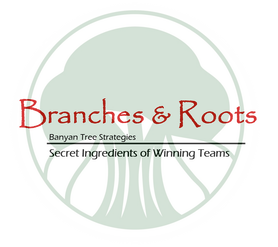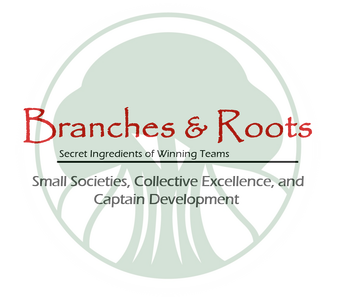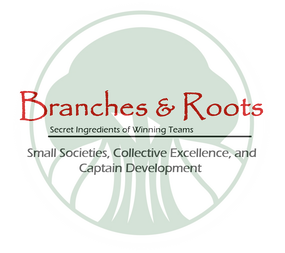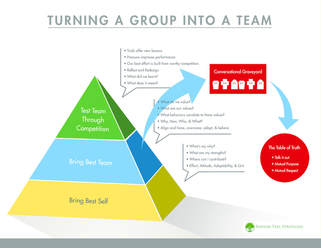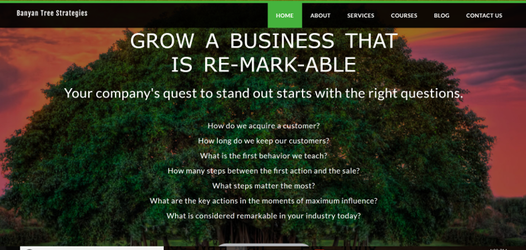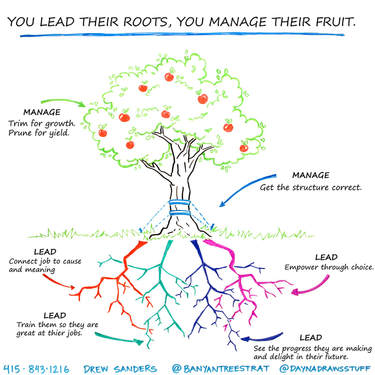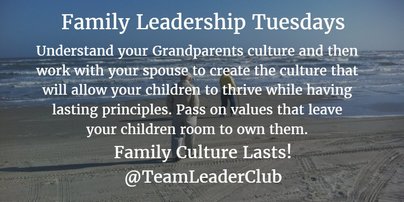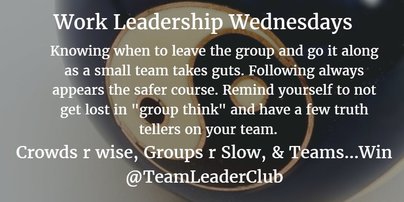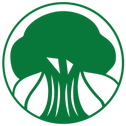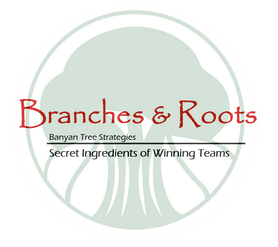 This is a series of articles from emails that we were sending out to clients and friends as the CV Crisis evolves. Hope it is helpful for others and also provides a historical context as we all reacted and learned about the seriousness of this virus. June was another month of adapting and learning how to decipher the signal from the wall of noise that was building. Now that we are past the midpoint of 2020 it seems natural to focus on where we should be by year's end, yet somehow it feels like we need to go further out. My question for you to ponder is this: Where do you want to be 1/1/2022?
In your planning consider thinking through what you can control and what you can not. Do your best to not waste energy or time on things you can't control, like whether we will have college sports on TV. You can't control if online school means you have children at home, but you shouldn't be surprised by it, allocate time to having a plan to help your kids thrive. It is very easy to envision the Covid Crisis costing the world billions and 2 years of disruption. What is also easy to envision is that the victors will say this period was where they honed their vision and adapted to become their best self and team. You won't hear much about these people on the news, the media will focus on the victims. As a leader of yourself and others, the choice is yours, Victim, or Victor. Let me know if you need any help setting up a 18 month plan, the first checkpoint is August 15th. Onward, Drew p.s. Way back in March we wrote about "Endurance" and as we start our journey to 1/1/2022 it appears Admiral Jim Stockdale's words are more helpful than ever: https://www.linkedin.com/pulse/cv-crisis-chronicle-march-29-implementing-principles-drew-sanders/
0 Comments
 One of the first things that can come to mind when making a plan is how long things are going to be this way. How long are you asking people to make sacrifices, how long until we get back to normal? How long is basically another way of asking WHEN? Getting things wrong by predicting a quick turn around on the when and how fronts seems to undermine your leadership in your own mind. In addition, many leaders don’t want to be wrong with too dire a prediction. We get caught in thinking that our adult employees are like a young child, and that we can’t scare them with the real information. Right now, all leaders are caught in the WHEN trap and this is why we think you should punt on the timelines but still have a PLAN. A great way to do this is to get the team focused on the daily key actions that lead to the long-term benefits of endurance as a competitive advantage. If your wondering what we know about endurance, we have unknowingly been acquiring some personal knowledge for decades and had a crash course the last 10 years due to some unforeseen medical emergencies. Our professional golf backgrounds highly correlate with endurance. I also have completed open water swims in Lake Tahoe and the Maui Channel where the duration of the competition is such that endurance, as a quality for continuing for a long time, is paramount. Our crash course has been on the medical front where within an 18-month period Sara was diagnosed with a bi-cuspid aortic heart valve that would require open heart surgery and both of Sara’s parents would be diagnosed with incurable cancers. The prescription you get with a bicuspid valve when you are in your late 30’s is to be as healthy as you can but to wait for as long as you can because post-surgery you may be on blood thinners for the rest of your life and a second surgery may not be possible. Sara’s parents were immediately put into surgery and then aggressive chemotherapy. Random numbers on charts become the norm, Google searches not very comforting, and seldom found is a doctor who got a minor in empathy. What happens when so many family members are in need of care is that you start to shorten up the time frames by which you plan. You go from thinking where your life might be in ten years to realizing that every 90 days or less you are going to be making new plans. You also start to understand that the PLAN now gets an asterisk next to it. The asterisk is then explained at the bottom of the page and it reads: “Plans subject to change.” Endurance, and the benefits of having a recipe for endurance (back to the definition at the top of the quality of continuing for a long time) started to become our constant companions. We also learned to be very aware of a mindset that can appear when the duration of a condition is considered to be unknown. That mindset is COPE. For the purposes of this nonscientific publication we are going to consider COPE to be something to avoid. “When you COPE you lose hope” is one of our taglines. This is not to paint coping as the enemy in all settings, in some rooms it is vital. However, for the purposes of this situation and the leadership challenge that is in front of us know, we are going to want to avoid allowing the team to get comfortable with COPING. We are prescribing the positive principles of Endurance with the aim that you will be able to use these to lead your team at time when you can’t give them an answer to when things will get back to normal. We will share a story from history of endurance and then offer some key lessons learned from that story. The stories can serve as inspiration to your team and then you will be equipped to share why your team will endure and then can use the questions we have provided to help the team navigate the upcoming week.  Endurance and the Stockdale Paradox James Stockdale was a POW for seven years in Vietnam with a significant amount of that time being in horrific and solitary confinement at the infamous Hanoi Hilton. In an interview he gave for Jim Collins bestselling book “Good to Great” he shared the dual mentality they formed to allow them to endure their situation and the indeterminate period that they were to be held captive. Here is a snippet from the book and the interview between Jim Collins and James Stockdale. “I never lost faith in the end of the story, I never doubted not only that I would get out, but also that I would prevail in the end and turn the experience into the defining event of my life, which, in retrospect, I would not trade.” When Collins asked who didn't make it out of Vietnam, Stockdale replied: “Oh, that's easy, the optimists. Oh, they were the ones who said, 'We're going to be out by Christmas.' And Christmas would come, and Christmas would go. Then they'd say, 'We're going to be out by Easter.' And Easter would come, and Easter would go. And then Thanksgiving, and then it would be Christmas again. And they died of a broken heart.” Stockdale then added: “This is a very important lesson. You must never confuse faith that you will prevail in the end—which you can never afford to lose—with the discipline to confront the most brutal facts of your current reality, whatever they might be.” Witnessing this philosophy of duality, Collins went on to describe it as the Stockdale Paradox. What a great line. “Confront the most brutal facts of your current reality.” What are the brutal facts of today as you see them? Could we see the basic confidence in the public stock markets shrink to historic lows? Do you have a plan in place to function as a business with the market at those levels? Do you have a plan for a key sales manager or a front-line manager to be sick and not able to work from home? It appears that this is a time for leaders to pull the team together and visit some emergency preparedness plans with more clarity and focus. Have a plan for things getting worse from here so that if that happens the team has practiced recently, and they will know that someone was thinking through this before and not just making it up as they go along. It is also a time to avail the unwanted fears of your clients and share with them what you are doing to serve their needs and the processes you have in place to keep them properly allocated. Your business will endure with certain habits and it is important to have your clients be mentally prepared to endure with you. It seems like if Admiral Stockdale was alive today, he would say:
These points of view give us courage and we hope that by passing this example of endurance on to you that you will be able to effectively lead your employees and advise your clients at this crucial time in our country’s history. We view your work as being essential to our country’s well-being. Thank you, Drew Your Leader Playbook for the Week
Here is your leader playbook for the week:
 Hello and welcome to a year that will have the Olympics in Tokyo and almost 150,000 hours of sports for you to watch on TV! Many of those hours will include close-ups on the coaches as they react to the play of their teams. In some cases the narrative of the coach is now longer and more compelling than the endless line of players who make it on the court of field. Who doesn't like a good Jon Gruden Smirk or Mike Krzyzewski squirm? It's similar to what we are doing as fans. In this edition of SIWT we take a quick look at the challenge the coaches face each season on the topic of gaining player buy-in and the unique choices a coach has between using their power or influence.  When Loss Aversion Loses Its Effects As a coach you have a series of common motivators that you can use, we have often pictured these motivators like spices on a rack that go into your coaching soup. You, the coach, have in your soup stock the normal base ingredients of effort, fitness, and strategies. The practices and the games then require you to pull from the spice rack the contexts and dynamics that help you deal with nailing the moment. All teams start as groups, and during the course of a season the teams can revert to group status in an instant for reasons that range from having a grandparent in the stands, to having a losing record, to having little on the line at the end of the season. The notion of caring about the ball and each other before caring for oneself is counter-intuitive to most. It's this hard notion that attracts so many to coaching. Team can be special and coaching a winning team can be life changing. Most of the spices are used to sharpen the focus of the players, to help them take the risk that comes from giving a full effort. Coaches know that the players will struggle to trust themselves, each other, and the coaches on how much better they can get. The standard the coach can see as their potential has risks. The tension between what a coach sees and what a player thinks is a normal part of that relationship and typically there are more players than coaches so the dynamic can get tense. Some spices are slow to take effect and can have long lasting positive impacts, we have written about these in our Secret Ingredients of Winning Teams white papers. Vulnerability, following, humility, and commitment are spices that really change the dynamic of the team. However, they take time to develop and they also require a large amount of trust to have been developed between the players and the coaches. Trust is seldom built from a power-based system and this is why so many of the spices that are on the coach rack work quickly but leave a bad aftertaste. A coach controls playing time, this is where their power has the most impact. A coach can use a loud voice and get players to move quickly out of fear. Some coaches don’t use a loud voice but prefer to undermine their players with passive-aggressive comments that allow them to still be in control but with a lower profile than the vocal coach. One of the standard power-based motivators is loss aversion. “Are we really going to lose to this team?” “Is this the group of seniors who are going to break the streak of making the playoffs?” Sociology research has proven that loss aversion has a higher impact than goal obtainment. One of the best examples is putts for par vs birdie on the PGA Tour. But eventually loss aversion loses its impact as does yelling, as does being passive aggressive. In fact, the dynamic that is really key for coaches to realize is that power has to be policed, where influence crosses borders without a passport. The coach will always have the authority and the responsibility for the safety of the team. The coach will manage the game strategy and tactics and select who plays. The coach picks when practice starts and ends and what the team will work on in practice. The players agree to adhere to the rules outlined by the coaches. Power and authority work well in setting this up, much like the pilot and flight attendants enforce the rules on an airplane. How the team behaves within that framework has everything to do with the influence the coach has earned. For the coach that only works from a position of power, and this will require a never ending amount of policing that can only be masked by winning. Winning creates buy-in from most constituents, and like perfumes can mask a lot of inconvenient smells. Influence is given by the player to the coach and is a precious offering. The player and the coach are both taking the risk of failure in front of others with the players taking most of the risk. Just picture the high school basketball player who bites on the cross over dribble and falls down in the 4th quarter of a road game against a cross town rival. The cascade of verbal assaults and embarrassment rain down on that player. The coach and the player should be entering into a state of consensual interdependence where both are seeking to use their time together to improve and grow together. Each has a role to play, each is sacrificing. The fully developed coach understands that it takes time to build influence with the players that goes beyond winning a game. The fully developed coach is aware of the effects of the motivators they use and are careful which spices they use during the season. Loss aversion being one that they know will work, but only for short periods and that other longer lasting motivators must be present in the team soup for real team fulfillment. Interested in other posts on similar topics? Check out our blog. Help Us Help Coaches - We Need Your FeedbackSara and I have supported coach development through a non-profit we formed 16 years ago, recently that non-profit was hired by a high school to work with over 100 coaches on building out a team why and an individual WHY for their season and helping tie the two apparently opposed agendas together.
In preparation we are seeking answers from people to the following question: In high school, how should the academic and athletic classrooms be the same and how should they be different? We are seeking as many answers to this question as we can so please give it some thought and respond with your perspective here.
 The Challenger Back in February of this year we highlighted a book by Sam Walker by the name of The Captain Class that identified the captain as a key element to long term team success. While digging deeper on the topic for our clients we noticed that the correlation of Walker’s captains with Glenn Parker’s work on team player styles and the most volatile team player style, “the challenger.” Parker's work was mostly inside large corporations in the 70’s through early 90’s but his book Team Players and Teamwork is still relevant today. His research lays out four traits for how people will behave when working with others: Contributor, Communicator, Collaborator and Challenger. Everyone exhibits all four traits when interacting with others, however, it’s the order they prioritize them that impacts the group. The group that prioritizes being a challenger is the smallest, and his perspective about how to work with and advise this group has been of prescient. Why you want Challengers on your team: “Challengers push the team to talk openly about problems and things getting in their way of success.” How others can react to a Challenger: “Ironically, many Challengers are accused of not being team players because they raise objections to team decisions.” What a coach needs to share with their Challenger: “The real mark of an effective Challenger is their knowing when to stop pushing.” Sports teams can be great places for challengers, the rules and boundaries allow them to flourish as they can focus their drive to excel and not be distracted by some of the constant changes of life. In work or family settings the challenger can be a bit exhausting to those with contribution or collaboration as dominant traits. Our key learning when combining Walker’s and Parker’s work is to empower the challengers to call the team higher while making sure they realize others will have different needs. If one of your highest performers is also a challenger consider having the team take the Parker Team Player survey so the rest of the members will have a better understanding of these traits. This can lead to mutual respect being maintained over the course of a season or year when tensions rise due to losses or setbacks in goal obtainment. As a leader or coach, establishing a common language for your team in some key areas is a big part of defining who is “on” the team. How people naturally want to act when with others is something you can leverage to help the group become a team. We hope Walker’s and Parker’s efforts will allow you to effectively identify your team’s traits so you can manage and lead them to challenge each other to find their best collective self. Interested in other posts on similar topics? Check out our blog. The Banyan Book
We are excited to announce coming in the first quarter of 2020 will be the Banyan Book, a compilation of our best practices, writings, and tools in a handbook for business owners and managers. As always, we welcome the chance to speak with you. Profits, Culture & Threats Hello and welcome to the final 45 days of the 2019, we hope it has been a good year for you. The team at Banyan is thankful for the contributions we have been asked to make. Business owners and managers are constantly thinking about profits, culture and threats. This time of year can be one of reflection and projection in all these areas and we have a few thoughts for you in each category.  Profits Are your people used to being pushed to have goals? Do you tell them what they need to hit to achieve a mythical number that most think is made to line your pocketbooks and not theirs? Do they understand how and why the goals are put together? If you would like a fresh look at goals and how they can help motivate your team, consider this post:  Culture Can you outline how you build culture? Most cannot. It’s a gut thing for many and a “I know it when I see it” response for others. Andressen Horowitz’s founding partner Ben Horowitz has another book out that is a worthy read for any leader. What You Do is Who You Are addresses the issue of how to build a culture. His first book The Hard Thing About Hard Things laid out that there is no recipe to building a culture or a company. His latest book takes on the root stock needed to make a culture soup and he does so with some historical reviews that will shock you. Our biggest takeaway is that sometimes you need rules that stand out so much they show off what actions will define your culture. Like fining NFL Football players for being two minutes early like Tom Coughlin did when he was shaping the culture of the New York Giants. The reason, the rule was all meetings started five minutes early… This book reminded us of Jack Clark’s talk a few years back about establishing values and then having questions that activate those values into actions that can be seen and felt by everyone on the team. They define who is not on the team as much as they show who is on the team. Threats We have two essays on this topic for you. One is about how you are using innovation and the threats you will face if you don’t understand what type you are fighting against, the other is more subtle and is tied to an internal threat you may face from your own people. If your people are always telling you what you want to hear and you don’t have an established way of getting in and out of hard conversations, then there is a really good chance they are also telling your customers what they want to hear. This is most likely hurting the company. Essay #1: The Difference Between Early and Late Stage Innovation Early stage innovation is what Keith Krach talks about with his concept of finding a beach head: Big enough to eat off of and small enough to defend. He should know, he has created four category-killers in his career and is now the Under Secretary of Economic Growth. Here is his point on beach heads: When you are seeking to be an early stage innovator you need adventurous capital that will be patient while you disrupt an industry. Late stage innovation is what Mike Maddock likes to talk about when he holds up an IPhone and asks, what can you do with this device to further surprise and delight your customers? You need less capital and more curiosity here. Most business owners are not in early stage innovation mode. They are in long-stage business cycles and earning a good profit margin which they control. The key in a long stage business cycle is to gain control of the profit. As a business owner it is important that you understand the game you are playing. Some examples of late stage innovation: • Professional Services • Law • Medicine • Financial Services • Insurance Services • Telecommunication Services • IT Services • Manufacturing • Software as a Service Examples of early stage innovation • Docusign (the world didn’t have a way to securely sign for things digitally) • Apple's IPhone (the world didn’t have access to email, text, phone and camera that they couldn’t be without) • Facebook (the world didn’t have access to their friends experiences that they couldn’t be without) • UBER (the world didn’t have a way to share cars that were personally owned) • Amazon (the world didn’t have a way buy almost anything and have it show up in less than two days) Mike Maddock asks us, how are you using the benefits of these early stage innovators to create a more pleasing and delightful experience for your customers? When you stay curious to the new while delivering the old, you may find that what you own and control improves in its financial fundamentals through customer satisfaction and new customers acquisition through the holy grail of “word of mouth.” Essay #2: When is the right time to have a hard conversation? Ask anyone in the C-suite and you will get something close to: Now is as good as time as any. Ask anyone further down the org chart and you are more likely to eventually here: Never is fine with me. This spectrum of answers reflects a common culture issue tied to power and influence and safety. Those with low power avoid conflict and those with power don’t understand why others are afraid of it. We always have fun with owners who have lots of power at work and ask them how it feels at home with their spouse…it usually gets the point across. The issue this difference creates is that the people solving the problems for customers, building products and services, and acquiring new customers are the ones that really need to have the tools to have hard conversations - and win those conversations - on behalf of the company. Innovating Like a Virus The fast fall finish is here, and after a quick inventory of the issues facing our clients right now we will outline a few and what we are doing to solve them. We think you will be able to relate and hope we have a solution or two that will help. If you have an insight of your own please pass along your thoughts here.  Current Issues Business Owners Are Facing The Issue: We are innovating and have a few of the right customers, but getting more of the right customers can be slog. “They treat us like a virus until they take the time to really look at it and then we are the cure.” We thought this quote from a sales rep really nailed it. Your offering is treated by the buyer like a virus until it’s the cure. The enterprise buyers really have a lot on the line when they are making a decision and the switching costs can be significant. They are right to be thorough, the stakes are high. Consider a three point solution that is working now: 1. Write about the pain the customer could be experiencing now in a manner which fits their attention span when first learning about something new. Don’t drop War and Peace on them when all they want is the 411. They should able to get the gist of what you do in less than 30 seconds and then have the ability to review for up to three minutes with your writing or video content. 2. Give them an example of a current customer similar to them and how it is working. The Case Study example can be a challenge if your solution is not focused, but start with three typical customers and walk them through the experience. This should be no more than a three to five minute commitment for the buyer and it will help them relate to your other customers. 3. Make the first dialogue option as short and sweet as possible while still having enough in it for you. Unless you are in charge of acquiring thousands of customers a year you really don’t need to be too concerned about tracking the first two data points in this example. You should be aware of the numbers but your first real leading indicator to track religiously are first time dialogues with a prospect. We suggest you use a 30 minute discovery call and really focus on the needs and outcomes desired by your buyer before you launch into your solutions. You should be updating your writing on points one and two at least twice a year, tracking your first time calls and asking the team why is this working or why isn’t this working on a regular cadence.  No Thanks, We Got This Taken Care of In-House The Issue: When your job is on the line, sometimes you would rather have an employee working for you than a contractor. The doing it yourself vs outsourcing it tension is very real in today’s economy. Employees are expensive, and yet the “at-will” contract creates the ability for the best to turn the table on the employer and leave on a whim. This often leaves only the average to poor employees who want to stick around to handle mission critical tasks. If the boss has their bonus or job on the line, sometimes they deal with attrition issues and building the team internally because they feel like they are more in control. These biases mean that if your company's offering is in any way reducing head count and outsourcing a service or skill, you had better be the A team. A SOLUTION Part of getting someone to let go of control is to help them understand where their time could be better spent if they didn’t have to worry about the problem you solve for. You can accomplish this by asking them to list out the top 10 things they deal with at work on a weekly basis, and then ask them which one has the biggest impact on their P&L. Chances are they are spending time doing and overseeing a series of low value-add objectives. When you can take those off their plate and allow them to refocus on their high ROE objectives you are making a different case for your joint success. For more on this topic click on the graphic or click here for a case study article from Distillery Tech.  Is It Time To Buy or Sell? The Issue: Should we stay or should we go? Business transactions are a big part of the reason we are hired. Sometimes it’s to guide the company to an exit and other times it’s to help them with an acquisition. In the age of disruption, the size of your balance sheet and a clear understanding of how long you can protect your margins can help you answer the question of whether you should be a buyer or a seller. An additional factor is the age and motivation of the ownership. Can’t get your customers’ attention? CONSIDER SELLING A big challenge for many companies is the attention span of their buyers: it’s really short and they struggle to keep it. Going back to our earlier example, the people who might do business with you think you are marketing a virus, while your customers know you have the cure. The largest player in your space doesn’t have this problem, their brand gets them in the door. This can become a significant competitive advantage. If the amount of time that the buyer has is limited, it is, and they are already doing business with that company, which they probably are, then you might want to consider locking up a couple of key accounts and then taking it to that larger player and allowing them to monetize it for you. John Chambers started at Cisco in 1991 and led one of the strongest sales cultures in the world. Cisco then took its sizable balance sheet and has purchased over 200 companies to feed its sales force and their customer base. Here is a white paper from the company on their acquisition process. Does your industry have an aging set of owners and no clear dominant players? CONSIDER BUYING If so and you are between 30 and 50 years of age, you might consider becoming an acquirer of these businesses. A great example of this is in the financial services industry. The wealth in the United States has typically been advised through either banks or brokerage firms. In the last 15 years the rise of the independent Registered Investment Advisory firm has fragmented the industry while it has continued to grow in line with the wealth of the country. High Net Worth individuals and medium sized nonprofits will attribute trust to an individual easily and this has allowed yesterday’s Morgan Stanley advisor to become today’s Registered Investment Advisory business owner. With most companies offering similar services to their clients, and the clients’ reticence to discuss their wealth with multiple people, turnover remains low. The term “client for life” is often used in this industry. However, the advisor does end up retiring, lives do end, and the assets and their associated fees and revenues leave. Some advisors don’t plan for this and they wait until the last minute. Others plan ahead. If you are in the middle of your career it can be a great way to grow your customer base. This is especially true if you are struggling to acquire new customers of your own. Your revenue per customer will be lower as you will be sharing that with the seller for a period of time, but if you establish trust with the customers and their dependents the life time value of the customer should make the cost to acquire that customer worth it. The Lesson: when growth is slow, acquire older players and recruit young service professionals. 2019 has been an extremely active year for our clients and their businesses, if you need help solving for any of these issues or feel like you might benefit from an outside voice, we welcome the chance to speak with you. Secret Sauce of Enterprise Sales Summer has arrived and the first half of the year for your business was either great, good, or just OK. As the leader you know that revenue is a form of a lagging indicator, and so for many businesses the third quarter is a time where your leading indicator (first time sales calls with prospects) can drop off a cliff. While you still have the marketing and sales teams working on the top of the funnel this natural drop can afford you a time to revisit your sales habits and processes. We recently worked on this exact issue for a company, and below is a window into what we built for them. Feel free to share it with your company and tweak it as you see fit. There isn't much intellectual property in sales processes, however, dedicated practice on the right actions of listening and communicating appears to be a timeless pursuit for the best. Just like Steph Curry's pregame workout and his practice sessions, they are re-mark-able. The very best pursue all types and forms of practice and they are re-lent-less in that pursuit. If your company wants a customized practice plan or a practice partner, just let us know. Our General Bias to Take Into Enterprise Sales CallsYou (our prospect) have been specifically selected:
What is the outcome that your company really really cares about?
If we can't kill this idea....then you should move forward with it....the key issue is how many and over what time period (WHEN)
The four legs under our platform are:
The secret sauce behind the process
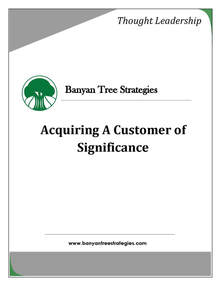 Why/What/When White Paper The above outlined process is an adaptation of our WHY/HOW/WHEN white paper on customer acquisition which you can access by clicking on the document or find it and other white papers on our website CONTENT page. Enjoy the summer! Secret Ingredients of Winning Teams (SIWT) The shorter duration of sports teams seasons allow for more efficient research and we also find they correlate well with companies, non-profits, and families. Secret Ingredients of Winning Teams (SIWT) is leading to the creation of a management process for coaches and businesses to implement. SIWT is for coaches and owners who believe the best teams are made when both the individual's and the team's needs are met. This dual goal takes leadership and management to a higher level, it's not for the lazy coach or boss. Our first edition focused on Vulnerability. This edition we turn our focus to Following. 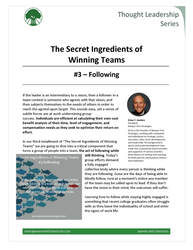 Secret Ingredient: Following If the leader is an intermediary to a vision, then a follower in a team context is someone who agrees with that vision, and subjects themselves to the needs of others in order to reach the agreed upon target. This sounds easy, yet a series of subtle forces are at work undermining group success. Individuals are efficient at calculating their own cost benefit analysis of their time, level of engagement, and compensation needs as they seek to optimize their return on effort. The act of following while still thinking is a critical component that turns a group of people into a team. Today’s group efforts demand a fully engaged collective body where every person is thinking while they are following. Gone are the days of being able to blindly follow, now at a moment’s notice any member of the team may be called upon to lead. If they don’t have the vision in their mind, the outcomes will suffer. Great Following Trait #1: Stay close and Observe Google may have replaced mentors as the best source of knowledge in general, but on a team the subtle needs and tricks to great performance are still passed on human to human. The closer you can stay to your immediate leader, the more they will pass along in either word or deed. First year cadets at West Point are taught to observe and adapt as they start the tightly manicured 4-year matriculation. There will be distractions everywhere at work, from coworkers, to trade shows, to all-hands meetings. Navigate all these with discretion and observe how your boss behaves and mirror it. Great Following Trait #2: Anticipate Some of the best teams in the world come in pairs, and seldom is that pair splitting each task 50/50. They often deploy a divide and conquer strategy with each one owning a series of duties and relying on the other to deliver on their stack. As the team builds beyond a pair, a collaborate-to-innovate strategy can start to evolve. It is at this point that the ability to anticipate the needs of others plays a key role in how great followers enable successful teams. At the root of anticipation is empathy. Empathy requires setting aside your thoughts and seeing the world through the eyes of another. New members of work teams who seek to serve the needs of the group first will not stay at the bottom of the totem pole for long. Great Following Trait #3: Be Comfortable with Conflict Universities may talk a tough game when it comes to deadlines, but ultimately the student is paying for the knowledge. In recent decades the school administrators have a consistent record of caving to student and parent demands. The workplace is a different story, the customer is a fickle and petulant king, and this can turn even the nicest boss into a frustrated time-constrained leader with very challenging demands. “Stop what you’re doing and get this done today! It has to get done now!” What happened to: “How are you, is everything OK in your world? When you get a minute could you step in my office to discuss our latest cool project that you will love?” Anyone who has worked for even six months knows tension and conflict arrive via phone, email, and text at a moment’s notice. Having a series of communication tools to work with others during times of duress is a game changer. Being able to work with conflict when you are in a low power situation starts with being able to frame what you are hearing, and then nailing what you can offer to the solution. When people disagree on the solution it is key for the good follower to grab the similarities that exist amid the differences, and then look for a good moment to share your findings. Master this trait as a follower, and your leaders will take note and your responsibilities will increase. A View into Our Future Tomorrow’s leaders will be challenged to get a population of individuals to buy into the need to follow as we have defined it. Those that can sell the benefits of supplanting the self for the group and create outcomes that feed the entire team will find that word of mouth among the members will keep a steady stream of applicants at their door. Very few enterprises scale without more people, and people having a good time while winning is contagious. We all want to be on that team. The question being asked is are you willing to follow long enough to get there? 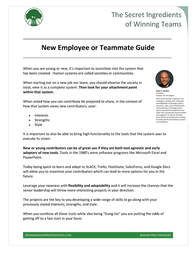 The New Employee We would like to highlight a specific moment when the individual is new to a team or company. One's ability to assimilate quickly appears to have a strong correlation with later success. Here is a quick guide for you or a friend to use when they are new:  Are You a Pirate or a Cowboy? There was a romantic comedy that had a bit of a cult following in the early 90’s by the name of “The Princess Bride” with a mythical character that was known as the Dread Pirate Roberts. He had a habit of telling his captives, “good night, sleep well for I will most likely kill you in the morning.” It was all an act, but he later explained that establishing a healthy sense of fear in people was the easiest way to lead them. Another movie that included people using a long journey to learn a little about themselves and leadership was "City Slickers" with Billy Crystal and Jack Palance. Palance is the sage cowboy who leads Crystal and his pals through a search for their one thing while managing a cattle drive. He used a group effort to help each individual find their role, and in the process the group became a team. Which leads us back to our question: which one are you and which environment do you prefer? A pirate ship or a cattle drive? Both are journeys, both have codes, and both have success that they can point to as validation for their way of life. Yet the two environments have stark differences. The pirate ship is a cauldron for bullies and the chief bully is the captain. On a pirate ship you are waging war both internally and externally at all times. There is blood everywhere and the sea is full of losers who have walked the plank. The funny thing about our work environments is that many people will tolerate bully behavior at work from a high functioning a..hole. The crazy designer, the coder who treats people poorly, or the sales person who crushes quota and everyone that comes in her path. Worse yet is the CEO who uses the term “radical candor” as a smoke screen to berate and belittle people who aren’t “all-in” at the company.  he hard part for the employee is that often times the pirates appear to be friendly and mostly human like in the “Pirates of the Caribbean” when the sun is out. They need people, lots of people, because they go through so many and thus they are very charming. Especially the CEO. But when the moon rises the pirates are all bones, and it is at that moment that the new employee realizes they have joined the wrong crew. In the right environment the employees are being challenged to push themselves on tasks that help the company achieve its goals and that also help identify the roles that each one is best suited to fill. The hero of the company is the product and the customer it serves, not the people at the company. Recently an open-source leadership outline of Bill Campbell’s work was compiled by the name of the Trillion Dollar Coach. It was compiled after 80 interviews of leaders that worked with Bill during his lifetime and include people from Google, Apple, and Intuit. We would like to think of Bill Campbell as the Cowboy leading all of us on the cattle drive of life. A place where through the hard work and the focus on the cattle you can find your role, and no amount of effort is spared in the saving of a lost member of the team or the herd. There are plenty of trials on a cattle drive but there are no planks to walk. If you want some tips on how to spot a pirate ship that is recruiting so you can avoid them, email us here. 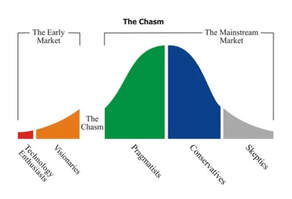 The Hard Thing About Innovating Geoffrey Moore is a best selling author of books that focus on disruptive innovations and technology. His best seller is "Crossing the Chasm" and it addresses the issue of going from the early adopter category of customers to the bigger section of buyers labeled “pragmatists.” Recently, he posted a short piece on LinkedIn about this still pressing issue for all innovative companies. I posted a question to his post and as fortune would have it, he responded with an answer. Our interaction and his post is compiled here in a PDF. To read directly on LinkedIn click here. The interchange gave us confidence that we are in alignment with a great thinker and adviser to the CEO’s of companies like Microsoft and Salesforce. It also allowed for some reflection on just how much the phrase “sales and marketing” is out of date. Professionals used to call the category of customer acquisition Sales and Marketing. Sales was first and Marketing was next, second, or last depending on the company. Sales and its people were the heroes.  In the past ten years the script has flipped and we now live in a world of marketing and sales. In our world the word marketing really means Thought Leadership Marketing (TLM). TLM for some is crazy, because their marketing is all about sounds and movies and clicks and moving a human through a process like a sheep about to be sheered. Those processes matter mostly for very small dollar purchases. Our clients provide goods and services to enterprise customers with multiple decision makers who all have different professional biases and disciplines that they own in their roles as CFO, General Counsel, or COO. These professionals don’t make decisions based on catchy headlines and short videos, they read and analyze data and facts. They want to see case studies and interviews with people like them who are faced with similar issues. These C-level buyers respond to thought leadership, and it is through this medium that you can then earn an audience and begin your sales process. The two processes are different, but they fit nicely with each other when designed correctly. It starts with a thought leadership marketing story-line that your company produces and it moves to an enterprise sales process which focuses on alignment, belief, and urgency. If you know of a company that is innovating and struggling with the chasm as Moore describes we have a Thought Leadership Customer Acquisition Program that is made for building the bridge that leads your products and services into the large pool of customers that are the pragmatists. Questions That Have Been Making an Impact One of the benefits of being a consultant is that we are in a lot of different “team” rooms and, like the honey bee, pick up lots of different pollen/ideas from each team. We have noticed that the right question can really stimulate engagement, creativity, and accountability. Here are a few questions that stood out as being particularly effective.
We hope they help stimulate and foster dialogue that leads to positive actions. Secret Ingredients of Winning Teams Six years ago Sara and I started Banyan Tree Strategies to help people build re-mark-able businesses and we are thankful for its success. In the midst of our work we started to notice a correlation between what we were doing for companies and our past experiences as professional athletes and more recently as youth sports coaches. What was our big revelation? Everyone wants to be on a winning team and nobody wants to be tagged as not being a team player. OK. We get it, big deal, everyone knows that already. Then why is it so hard to repeat as a winner, and why do most teams fail? We took what we are learning from CEO’s and are applying it ranging from college coaches, to people coming out of college looking to grow their networks, to 6th grade lacrosse coaches. Four times a year we will share our insights called “The Secret Ingredients of Winning Teams,” a topic we have touched on at various moments in our Banyan Tree Branches & Roots Newsletter. We hope our research can help you in your efforts to build winning teams in all facets of your life. These are the themes we are currently following: • The coach’s pursuit of collective excellence • How small societies impact performance • The evolving role of the captain 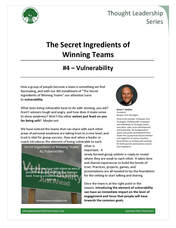 Collective Excellence There are many noble pursuits for a coach at the beginning of the season and we hardly ever bump into one who is volunteering their time in the hopes of causing a kid to quit the sport. However, if we were to vote on one of the hardest goals to obtain, we would put achieving collective excellence above going undefeated and winning the all-city title. Our definition of collective excellence has its roots in the work of John Wooden and those who also seek to build a personal relationship with each player in the joint pursuit of the team’s goals. The ability of the coach to build trust with the player, to such an extent that the player can agree to the role the coach has constructed for that season is crucial. It's part sales pitch and part plea for support and trust. Each season is as an opportunity for the coach to have a scouting report done on themselves, a book as it were. It answers the question, how do we beat this coach? Scouting reports are common on players: what is the book on that guy?
A coach should also want to know what “the book” is on them at this point in their career, and then work the next season to improve. So what is the book on you right now? The coach who trusts his or her team enough to be vulnerable with them should be well on their way to existing in a state of consensual interdependence with the rest of the coaching staff and the players. We wrote about this in one of our Thought Leadership Series pieces shown here. The pursuit of collective excellence begins with the coaching staff and then continues through to the players. If you can think of a team you were on that achieved this, please share with us as we continue to build out stories on this topic.  How Small Societies Impact Performance We first heard this term small societies from UNC women's soccer coach Anson Dorrance in a talk he gave at the What Drives Winning Conference in 2015. It was a scant reference at the beginning of the talk (minute 1:15), but for geeks like us, it was cause for research. Dorrance is a coach in pursuit of collective excellence. He is building a cumulative chest of wisdom on the topic of human collaboration in the pursuit of putting a ball in a net and caring about each other in the process. His research led him to discover Cesar Luis Menotti of Argentina who had the high pressure job of being that country's national soccer team coach. It was Menotti who started talking about the teams within the teams, calling them small societies when describing the relationships between the goalie and the fullbacks, the right midfielder with the center forward. It is similar to Metcalf’s law of networks and how intertwined our relationships can get.  Our current learning is this: Consider looking at your team the same way you would look at this square. You know you are going to be asked, how many squares can you see? If a square is a small society that could exist on your team, how many can you see? Make a list of small societies for your team and then if you feel like it, share it with us. As the coach, you can’t advise and mentor what you can’t observe. We have reached out to Dorrance with no success to date. If you have a link to him, please let us know as we would love 15 minutes to have a conversation on his current thoughts. 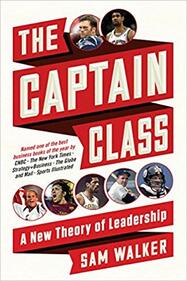 Oh Captain, My Captain No topic has captured our attention in the area of teams more in the past six months than the role of the Captain. Both Sara and I were captains of our high school and college teams. Both of us found it an arduous role to fill. In the decades since we have spoken to countless others who had similar experiences and were delighted to find that Sam Walker did years of research and published “The Captain Class.” His goal was to answer one of the most challenging questions in the history of sport: who are the best teams of all time? In all sports, in all time? Talk about a Mt. Everest goal. He also had a second goal. If he could make a claim that there was one class above the rest, did they have any characteristics in common? Turns out he could and there was. It was that they had a certain type of Team Captain. He then went on to identify that those captains had seven characteristics in common. This was pure catnip for us and led us to interview as many college, high school, and youth sport coaches we could and ask, if this is true, then how can you incorporate identifying potential captains and then developing them as part of your program? What we heard and how coaches are changing what they are doing in response to the data is encouraging.
We will continue to review this effort in this section of the publication. Here is a copy of what we send to coaches prior to our conversations with them, feel free to send it to any coach you know and we would love their advice and comments. Thank you so much for your readership and engagement with our research on building and maintaining winning teams. Winning together is a jump for joy moment and we think those are worth the blood, sweat, and toil that goes into being collectively excellent. We will be back to you in the middle of May with our latest insights that we glean from our network of awesome contributing coaches and leaders. The First Pivot of the Year Welcome to the middle of the first quarter of 2019, which for many business owners is a vital check-in moment. You may have been planning for a great first quarter of the year since the end of last summer, and now that future is your present. What is going the way you planned, what isn’t, and why? We spent the last 45 days traveling, visiting companies, and attending a few conferences with clients. We are happy to share our insights on the three themes we are going to follow this year as we seek to help our community run re-mark-able businesses. Themes for 2019 • Thought Leadership and its impact on your business • Customer acquisition frameworks • CEO leadership challenges  What is New in Thought Leadership Email continues to be the killer app for developing and maintaining a respected position with your clients, customers and prospects. Recent data shows that enterprise and individual customers spend the vast majority of their time reading and communicating inside of an email application. What does this mean for you? It means that unless you have a business which really wants to attract a customer that it doesn’t know and offer them a commodity (think owning a McDonald's franchise) you don’t really need to spend a ton of money on social media. Your best course of action is to have a well-developed email communication plan that integrates with your website and sales team. Key Insight The frequency of your email communication should depend on the type of service or product you are delivering. It can range from a travel service emailing you multiple times a week, to an estate planning law firm that shares its findings once a quarter. If you want our advice on what your cadence should be, click here.  What is A Customer Acquisition Framework? Consultants can bring diversity of thought to a company, they also bring new terminology that at first glance may not make sense. We use a customer acquisition framework (CAF) to describe how a business wants a potential customer to learn about, and then accept its offer. It might be called sales and marketing and in other places it’s called marketing and sales. Regardless, the biggest change we have noticed in this area are the options available to your company relative to just five years ago. That is why it is one of our themes for 2019. It might make sense for you to revisit your strategy. In 1995 the phone and the fax machine were the money makers, and having a toll free number was a big deal. You might have had a marketing department, but you didn’t know what worked and what didn’t and the magazine ad salespeople were really happy about that. Today marketing executives can show up to a meeting with real data that tracks and predicts future behavior by your target customers. What does this mean for you? It means you have more leverage with your marketing dollars and your sales team. Just ten years ago you were still guessing with your marketing dollars and the sales reps could hold you hostage with the relationships they initiated. Key insight In the House Tour image below think through how far you could have a potential customer get without the help of a sales person? As an owner you have an incentive to get them as far through the house as you can. Get this right and your cost of sales will plummet and your profitability will rise.  CEO Leadership Challenges Somewhere between Salt Lake City and Grand Junction this January while climbing a scary mountain pass in a four wheel drive it came to us that a way to look at the CEO’s job is as follows: To determine how much stress the balance sheet of the company and the people that work for it can handle at this time in the company's life. You may have a different view of it, or a different way to say it that works for you and we would love to hear from you about how you see it, but humor us for a minute. It appears at times that even at some pretty large companies that the only person who is really thinking about the future of the entire enterprise is the CEO. Everyone else is in their department looking for more resources, and hopefully in the words of Peter Drucker, focused on the next most important task. What does this mean for you? It means you need to be relentless in your pursuit of what is true from your direct reports because they may have an inherent bias to keep you on a consistent drip of flattery and fluff. It also means that having a board of directors that can help you think about the company from the outside is vital. Questions a good board can help you wrestle with are: • How much debt should we be working with now to grow the business? • Where are your next threats coming from? • What innovations are going to allow you to increase your margins? • Where is your current leadership team in their own personal life cycles? The rub is that building and maintaining a productive board of directors is a challenge. Too often it is such a hassle that you don’t even have one. CEO’s can often feel like the coach of a professional sports team. The players on the field are your employees, the fans in the stands are the customers, and up in the owner’s box sits the board of directors. Where does the coach stand? Sometimes they stand alone. Key Insight Ask yourself the following question: What is the company telling itself right now that we want to be true, that may not actually be true? Many department heads will be talking about growth because they know that is what everyone wants to hear. The challenge is that if the company doesn’t manage its balance sheet and time the growth correctly outside forces can end up owning the business. You may have a growth mandate, but try as we might most of us can’t make water go uphill, so back up your mandate with facts and processes you can trust and measure. This rigor and dialogue can save your business. See You at the End of Q1 That’s it for now, thank you for allowing us to drop into your mailbox six to eight times a year with our insights from the road. We love helping interesting people build re-mark-able businesses that “never stop growing.” Email us here if you want to start a conversation. 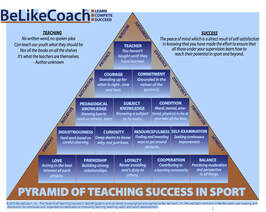 Dancing With Your Best Self in 2019 During the biggest gap week of the year we send you our warmest thoughts and pledge to continue our quest to write great content on how to bring your best self and team in 2019. An Enlightened Breakfast Recently I had breakfast with a friend and he exclaimed: “Sanders you have to watch the movie “Free Solo” about the guy who climbed El Capitan at Yosemite without a rope! It is the most amazing physical and mental personal achievement I have ever seen.” My response was: “Awesome, I will go see it.” Then a challenging notion came to mind and I made an assertion: “You know, when you try and to climb it with 2 to 100 people together is when the whole plan and challenge changes.” Free Solo We ended up having a great dialogue about the differences in trying to lead a company where you are telling people to be their best, and yet are not sharing and teaching how they should work together to accomplish the mission of creating a remarkable customer experience. Looking back on six years of running Banyan Tree Strategies, much of what we have been sharing with you has been about that gap or transition. The leader's challenge of teaching people to go from the one, to the few, to the many while achieving collective excellence. Learning how to work together well is described in the second layer of John Wooden’s pyramid of success, going from best self to the best team. Some relevant recent work has been done by a group of Wooden’s players and fellow professors at UCLA. It is called “The Pyramid of Teaching Success in Sport.” Wooden’s challenging call to coaches lingers in this pyramid when he said, “You haven’t taught, until they have learned.” We Are Splitting Branches & Roots Into Two Publications • One will be focused on business owners and continue our eight times a year cadence. • The other will look at the secret ingredients of winning teams and be published quarterly. Building A Re-Mark-Able Business Banyan Tree Strategies serves business owners who believe that growing a re-mark-able business is a worthy pursuit. Our content is for owners who want to know more about how to lead their people, position their services correctly, and win the new business they desire. Our pledge is that by engaging us you will build a business that can double in size every five years. We will follow four themes to help your business grow. • The effective use of thought leadership to drive new client engagement. • Customer acquisition frameworks that are working currently and how to scale a sales force. • Managing transitions with key people and potentially the sale of a business unit. • Challenges facing the C-suite and how to manage and lead your direct reports. The Secret Ingredients of Winning Teams The quarterly content will be for people who believe that building and maintaining small societies (teams) is interesting. It is for people who want to know more about what makes certain teams different than others. We hope that by reading our thoughts on teams that you will be empowered to be a better teammate and leader. The non-profit we founded in 2005 and still run today is focused on serving youth sports coaches. We will share with you what we are doing to serve these coaches and you will get an early look at what we are building to allow them to be better at their craft. You will receive our email on February 15th, May 15th, August 15th, & November 15th and our goal is for it to be a less than five-minute read and worth the time. Our view is that everyone is a coach to someone and that the best ones loved to be coached. However, it is quite a challenge to go from individual learning to group learning and this is where John Wooden’s quote “you haven’t taught until they have learned” leaves many of us challenged and wanting. We look forward to sharing the journey of 2019 together and appreciate your readership and advice along the way.
Drew & Sara P.S. Our first offering for coaches in 2019 is going to focus on what to share with someone when they don’t make the team. Any thoughts you have on this topic are welcome. 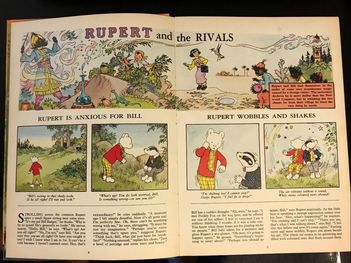 Why It Matters to Let Your Readers SCAN, READ, and STUDY Your Content In this edition we are going to focus on how people are currently processing new information and how you might position your offerings. For illustrative purposes let's look at our topic through the eyes of Rupert Bear of the fictional town of Nutwood in England. The Rupert books teach us how to position your content to a new potential customer. Below we will compare how a young reader and a new customer might have a few things in common. These books have a personal connection for me as my mother loves the comics, and upon returning from England she always had a new Rupert Bear book for me to enjoy.  The SCAN - Sitting with mom and having her read to you while you look at the pictures The Young Reader: Rupert Bear is well positioned for the earliest of children. The colors in the book are attractive and each page has four scenes that can be understood without words. Picture reading this to a three year old. You are snuggled up on the coach reading aloud the bold titles and pointing to the scenes. The child is taking it all in and scanning. The New Customer: When writing for an audience that is busy and may or may not be that interested in your offering, it is wise to allow them a chance to be able to digest some portion of knowledge from a quick scan. This allows you to benefit from their innate curiosity and potentially earn the chance to have them read what you have written. 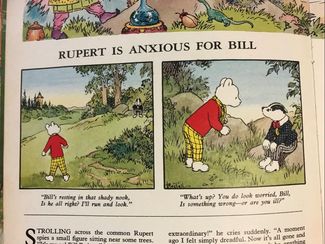 The READ - Reading with Dad and learning how to sound it out The Young Reader: The next stage where Rupert works well for your growing child is when they are now learning how to sound things out. You are again snuggled up on the couch and these familiar pictures are there to help the child read the captions (which conveniently rhyme.) The meter and pace of the experience is well suited for the child, they are on their way to learning a key life skill, the joy of reading. The New Customer: After the new customer has scanned your writing and chosen to learn more, you still want to allow them the chance to read only a little and be smarter than they were before. Give them a framework such as "here is the scoop and the skinny on this topic." They don’t have time yet to move forward with you, but you will earn points with them if you teach them something relevant quickly. We advise doing this with bold titles and pulled-out captions. 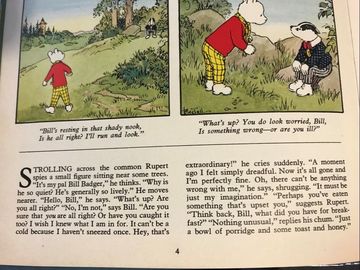 The STUDY - Reading on your own for comprehension and action The Young Reader: At six or seven the child is reading the writing at the bottom of the page and they now have years of interacting with the characters and the story lines. The parents are happy to pick up the latest Rupert Book that can travel with the child and know that thebook will consume time and attention with all the positive outcomes that accompany reading. The New Customer: The holy grail of business writing is to have a person of influence get past the first two steps of scanning and reading and actually study what you have to say on a topic. These are the people that make budgets, decide on purchases and lead others. The long term rewards of having them think with you and potentially learn from your deep insight are significant. You also benefit by not being there in front of them. They don’t have the distraction of dialogue, they are alone and have time to think. Get this part right and you are on your way to mutual success. The Fastest 105 Days of the Year Welcome to the early fall reset from the team at Banyan. Wait, isn’t it still the beginning of August? Why are we talking about the fall? The answer lies in the nuanced tension that exists between our weather-defined seasons and our local school districts ever-changing calendar. Over the past decade school has gone from starting after Labor Day to early or mid-August in much of the country. Thus begins a 105 day period of the year that takes us right up to Thanksgiving. From our experience this fast fall finish is chock full of commerce and commotion. Here are a few of our ideas and tips for you to consider in the different theaters of your life. YOU We advise people to create a word for each calendar year that can act like a north star. If your word got lost in the fragmentation of summer, considering puling it out and reorienting your heading. Jon Gordon does a nice job outlining this here. Right below that vision-crafting word sits a series of goals which can often be tied to a personal mission or quest. What is possible for you in the following areas in the next 105 days? • Self • Marriage • Children • Extended Family • Work • Community Service • Recreation An insight we have benefited from in recent years is that we can’t do it all, and that we are not proficient when we switch between too many tasks at once. Consider pulling out our task organizing template and sit down with a trusted friend or spouse and prioritize your mission critical projects. If you need a listening buddy, email us and we would be happy to lend you an ear. 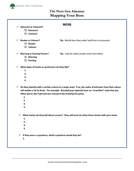 YOU AT WORK Hopefully you kissed some of the joy of summer as it flew by, put the memories in a jar, and blessed them with gratitude. Being able to do this, regardless of how full your jar is can be vital as you shift your focus to the fall. IF YOU HAVE A BOSS: Put yourself in their shoes and think through how they are looking at the next 18 months of their life. Understanding begins with observation, and if you are looking for a primer to help you in this area consider using our mapping your boss template. IF YOU ACQUIRE CUSTOMERS: If you acquire customers for your company and have an annual sales number this time of year can be fantastic or frightful. Careful pipeline and funnel management will help you decide where to allocate your most precious asset: your time. Here are a few questions for you to review: • Can the prospect live without your offering now? • If they have determined they can’t live without your offering, do they have the dollars budgeted for this year or next? • After they have become a customer, who is going to be your internal champion of your offering for the first 18 months? • What are the chances that internal champion leaves or gets promoted during those 18 months and do you have a backup person identified? • Within your pipeline, where are your gaps? Are you falling in love with your later stage deals that still have hair on them because you don’t like the rejection that exists in the early stages? Be careful of this trap at all times of the year, but especially right now. IF YOU RUN A TEAM: If you run a team or own the company, then you are most likely looking forward to getting back to full strength. The summer feels like you are 20% light as people take time off. If your metrics show you are behind it can be a difficult time for you. Part of you wants to make dramatic changes and only see the downside in your market and your people. Some business advisers suggest a strategy of tilting the table on your people in order to keep them paranoid and always on edge. We have labeled this the Superbowl Myth because so many leaders try to emulate sports when motivating their people. The challenge with this notion is that sports teams have off-seasons and athletes are typically playing for less than three years. They are in the entertainment industry, which is always looking for something new. It is by definition transitional. In contrast, many companies are looking to build a relationship with a customer that is as long and as mutually beneficial as possible. A great way to increase the lifetime value of your customer is to have employees that are able to think creatively and in harmony with each other, and the customer. They are constantly innovating together. Consider setting up a thinking framework that allows you to see how you and your team are working with and dealing with tension. Are you only able to get things accomplished when you add so much pressure that it is like throwing a tiger in the room? Or, do you have a heading established and are moving towards that heading with the pace and purpose that comes from everyone being on the same page with respects to the priorities? Setting a goal and allowing the right amount of tension to build within a team is the leader's charge. Chances are your team is not trying to win one championship and then take three months off. You need to win every day. Think through the game you are trying to get everyone to play, and then seek to enter into a state of consensual interdependence with your team to properly prioritize the work goals together. YOU AT PLAY Steven Johnson TED Talk - The playful wonderland behind great inventions. If this summer taught us anything it is that the blending of science and art makes for an amazing cocktail of creativity in both settings. With fall being such a season of production, we end with the suggestion that you allocate some daily time to whatever art distracts you the most. No matter the form, consider building in some unstructured play to your day. Don’t worry about accomplishment inside your art. Do it for your soul. Watch what happens as things from the pursuit part of your life fall into place almost by accident as you are having fun. We wish you a great start to the fall, and will be back in October with more learning and observations. For more of our writings for business visit www.banyantreestrategies.com and for our writings for people visit www.drewsanders.com.
Confessions of a Glue Sniffer Don't worry, we have not picked up a new bad habit, a recent trip to the library had me opening up a new book, and the combination of the adhesives and paper gave off a smell that made me smile. If you can imagine that smell right now, then you might really enjoy this edition. When it comes to summer reading, word of mouth seems important. We just don’t want to make a book purchase and end up with a dud. With that in mind this edition of Branches & Roots is focused on 12 book ideas for the 12 weeks of summer. We hope you find one of our selections interesting and that you find the time to read (or like many of us listen to the book) while the days are long and the nights are short. We have divided up the recommendations into five categories:
Most of these books are not new but they all were worth the investment of time, money and enrichment a good book can bring. 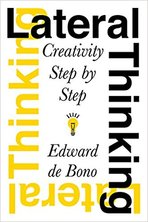 YOU Lateral Thinking by Edward de Bono De Bono has 57 books to his credit and at 85 years of age has spent a lifetime working on how humans think and communicate. Lateral Thinking is from 2015 and is an easy read, perfect for anyone who wants to balance the linear thinking taught in most schools or companies with a different discipline. If you have children or grandchildren that are middle school age or higher, de Bono’s concepts may be timely.  YOU and OTHERS Friend of a Friend by David Burkus Burkus is making a great contribution to the current generation of college graduates and in this brand new book does a proficient job in helping the reader realize how to look at their relationships. A key insight from the book is to think of yourself as not owning a network of people, rather, we are all embedded in an network of relationships which is always changing. We agree with his perspective and constantly attempt to seek ways to contribute to our network, and are consistently amazed by the outcomes. A new college graduate might benefit from this book. As an aside, we serve the college graduate community with our “How to Land a Killer Job” out of college course at www.drewsanders.com/courses.  Measure What Matters by John Doerr John Doerr of Kleiner Perkins fame shares the operating system that Andy Grove taught him while he was at Intel. He has used this framework with great success with companies like Google and The Gates Foundation. We found the book to be excellent, and the audio book amazing in that the people in the story read their own parts. As you head into the summer and are looking for a way to have more of your front-line people and their managers think and act well, we can't imagine a better business read. Prior to this book we have been helping clients implement our Banyan frameworks for execution. Now with this work in the public domain we will be tweaking our templates in a 'tip of the cap' back to the mastery of Peter Drucker and Andy Grove. This is a timely book for people who are leading others. 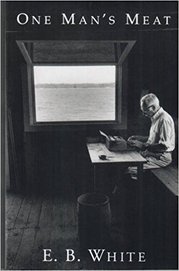 HISTORICAL PERSPECTIVES One Man's Meat by E.B. White White, of “Charlotte’s Web” fame was a writer from the northeast who left Manhattan and moved to Maine to live on a small farm. He wrote about it for Harpers Weekly, and the collection of these essays “One Man’s Meat” has been in print for over 55 years. This book is easy to have on the bed stand because the lifting is light in both subject matter and duration. Each essay is only 3-7 pages long. White’s reflections struck us as timeless. He is writing in the late 1930’s and into the early 40’s, a time of international tension. His efforts to run the farm and his ability to correlate those experiences into life for the reader amidst the current tension is applicable today. If you aren’t sure the world is going to be around tomorrow, or know someone who is up in arms currently, this could be their perfect summer read.  Blue Highways by William Least Heat-Moon Heat-Moon’s writing could create the beginning of at least ten songs per page. His observations of people and places and their interdependence astound. What struck us about his telling of what he saw and heard while driving the United States in the 1970’s was the practicality of the American public. Put these observations through the lens of 40 years of history and it could give those in a current state of flux a reason for hope. The writing is robust, his angst is present, but not overpowering, and the historical insight into our countries people is refreshing. 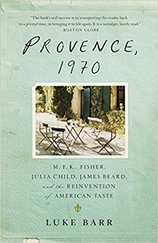 Provence, 1970 by Luke Barr Luke Barr is the grandnephew of noted food writer M.F.K. Fisher. He stumbles across her journal of a trip to France in 1970 in a storage unit in Hayward, California and discovers that some of the people who changed food in America were all there together by chance. Julia Child and James Beard joined Fisher that winter. They were the leading voices in the American food world, and during that season in the South of France they charted a new course for cuisine. Barr sets the stage for the encounter with the touch that only a family member can, and the direct quotes from Fishers journal reveal her grace and strong perspective. This book might be for the foodie in your life who wants to be connected back to a historical moment that, according to the author, changed our habits even to this day.  FUTURISTIC PERSPECTIVES Conspiracy by Ryan Holiday Conspiracy is an uncomfortable book. It dives into the current events and legal battle between Peter Thiel and Gawker Media. The first and fourth amendments have been getting a thorough cleaning by the lawyers in this case, and the ramifications can impact us all. Not only is the legal battle of interest, the author is one of the leading influencers of young professionals and is an avid stoic. Holiday will be influencing professionals for decades with his growing following in the hundreds of thousands. Read it, don't read it, but our laws make our rules, and the people who seek power like to change our laws. Questions that come out of this book are challenging. Should we conspire? Is it a bad word? While this book is a look back at previous events, we view it as a look into our future, as the actions of a politically active billionaire in his 40’s might be viewed as a prologue. 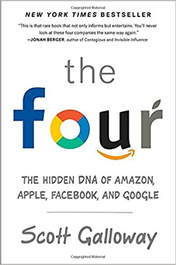 The Four by Scott Galloway Galloway is a successful early 50’s business school professor at NYU who also calls himself a serial entrepreneur. This book might be interesting to anyone who is using a smart phone, shopping online, socializing online, or searching online. Basically that is all of us. Here is the twist. Galloway, while giving us the cool details about the companies, then comes out and suggests that we the public and the U.S. government have been giving them a business pass. He suggests we need to keep them in check, that they have gotten too big and we need to channel our inner Teddy Roosevelt and break these behemoths up. A recent article in the Wall Street Journal - Tech Titans Tiptoe Towards Monopoly - touches exactly on this subject and the historical similarities of previous monopolies with these modern giants. Galloway likes to write things that make you ponder. This book does just that. 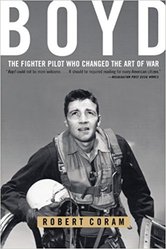 LEARNING FROM THE LIVES OF OTHERS Boyd by Robert Coram John Boyd is said to have changed the art of war in the sky. Author Robert Coram takes us deep into the mind and daily life of the famous fighter pilot turned airplane designer and Air Force pentagon politico. The historical look at how our government was assigning contracts and how the different branches of military were fighting for budget is an eye opener. Another key learning from the book is the OODA loop that Boyd created and preached to all his followers. Observe, Orient, Decide, & Act was a matter of life and death for Boyd as a fighter pilot. He lived his extraordinary and chaotic life by the loop and the simple decision to do versus be as an Air Force officer. Military buffs and business leaders will enjoy this book.  Scalia Speaks by Antonin Scalia A medley of Antonin Scalia's speeches were compiled this year in the book "Scalia Speaks" and are presented by one of his sons. The chance to reflect on his life and his decisions is perfect during the summer. He thought well, wrote well, and loved people and America. Would we all be so lucky to live like Justice Scalia and to make the contribution we were meant to make? This book is another light read as you are taken to a variety of locations and you can read a speech at a siting. The subject matter is actually lighter than you might think coming from a Supreme Court Justice, and his wit keeps you turning the pages with ease.  Personal History by Katherine Graham This book is getting some fresh press with the success of the movie The Post with Meryl Streep playing Graham. Graham won a Pulitzer Prize for this book when it came out in 1998 and she died three years later. The 20 years have allowed her actions and leadership to come into a brighter light. History will be kind to Graham and she earned it. Some of our insights from the book are that leading is a selfless and selfish act at the same time. Leaders and their followers, when in sync, are in a state of consensual interdependence. We think learning from Graham will help anyone aspiring to take up the charge of leading others.  Without Precedent by Joel Richard Paul The story of our country's beginnings and the lives of its leaders becomes more astounding as we stack decade upon decade on their thinking and actions. Washington, Jefferson, Adams, Franklin, and Hamilton have been receiving much of the attention. Yet the low cousin of Thomas Jefferson might be worth our attention. The author Joel Paul makes the case that our three branch system might not have existed if not for the strong will and mind of John Marshall. Marshall’s personal life and adventures are of interest, as are the feuds with President Jefferson as the courts grew from a group of traveling deciders into the keeper of the constitutional conscience. Anyone interested in the history of law and our countries founding will enjoy this book. We will be back in July with more leadership and team building insights. Until then happy reading....or listening!
Encouragement, Failure, and Observing Tick-tock, tick-tock, the clock keeps moving towards May 15th and the longer days and warmer evenings of late spring. The business calendar has many of us on planes, staying in hotels, and meeting with interesting people. The common questions are: What’s possible? When can we get it done? What’s next? Several themes have emerged for us in the last 45 days that are worth sharing. Encouragement, failure, and observing appear to not have much in common, but in the course of our travels we saw a common thread.  Pass the Encouragement Billy Graham died on February 21st, and we were struck by the breadth of personalities that weighed in on the impact of his teachings. One particular quote stood out and we decided to email it to a few people under the heading of “everyone needs some encouragement." It had to do with his response to a question he got at a conference later in his life. He was asked, “Who is the next Billy Graham?” He replied. “You all are the next Billy Graham.” We received a very high response rate in which people shared their own experiences and passed the encouragement back to us. We are hoping for a similar result in this newsletter. Encouragement came up around another topic that is timely and has to do with inspiring women and girls to lead. It is speculated that confidence can sometimes be missing from the minds of women and especially pre-teen girls. Encouragement from others appears to be a key ingredient. Katy Kay and Claire Shipman’s recent book called “The Confidence Code” outlines it in detail. We highly recommend either the adult or children’s version. Of course as word geeks we like that in the midst of the EN and the MENT there is something we love…. A huge dollop of COURAGE. Free-Falling Into Failure Working with companies, non-profits, and sports teams affords us a wonderful window into the world of effort and outcome. Goals are set, causes are cared for, and games are played. A haunting question lurks in many of the minds, what do I do if I try my hardest and fail? Seldom do we hear it verbalized, but we notice that much effort is made to sabotage the effort piece of the equation to allow the players a margin to recover their pride when the outcome is below the standard. It's much safer to reserve some effort and hope for success, if it gives you a nice mental pillow to rest your ego on..."well I didn't go all out so next time...." Our question for leaders is, what is this mindset and handicap doing to the productivity of your team? If you could minimize it and get your team to deal with success and failure with the same attitude, what would that look like? Under pressure we don't rise to the occasion, we fall to the level of our training. Achieving this outcome is no easy feat. One of the steps in getting there is done by providing a safe area to communicate what trying your hardest looks like, and having a recovery element to reward the effort. If people will risk their best in front of others, then when their limit is met, consider celebrating and providing them sanctuary to recoup and reflect. The power questions for leading a team to risk more, think more, and do more are: what did we learn, and what does it mean? As the leader facilitates the questions and honors the responses watch the trust on your team soar. We think other things will soon rise as well. 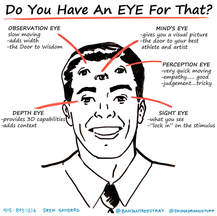 Observing Your Next Sporting Event Pitching in to support your children in their endeavors has a name. It’s called parenting. It’s a noble role and duty that changes with the decades. Currently from the ages of 4 to 14 there are many different roles a parent can fulfill in the area of youth sports. The roles have different levels of authority and requirements. Head Coach, assistant coach, team manager, culture keeper, league treasurer, league president, end of season of pizza party planner, are all roles parents fill. Both Sara and I have enjoyed participating and working with the kids and others parents these past ten years. What caught our eye this year is that after moving towns, we went from a head coach, league president, large authority role to that of an assistant coach. The opportunity to not have to coordinate and orate to 15 players on a team and to 200 players in the league and 30 to 400 parents left a void that allowed an observation framework to appear. This year we had room to see players individually be afraid of failure and to encourage them. Our interest in building framework for others to use also led us to come up with an observation grid to reflect on what the next step in each player’s development might be. This concept of an individual’s next step has excellent cross-over for the business world. Team sports are like companies. It is really easy to get lost watching the ball and only focusing on the key players. In youth sports, we have a charge to use the sport as a constraint to develop the player’s character and foster an interest in putting forth a maximum effort towards a shared goal. “Do your best for the team and learn how to smile and adapt in the face of adversity.” It can be fun and it can also be hard. In fact the fun meter changes over time. Sports Fun goes from going to the ice cream store kind of fun to climbing a hard hill fun. Matching the challenge to the age group and interest level can be difficult. With this in mind and with my new role allowing me time to observe, we came up with a sequential set of questions. 1. Did we observe the player hustle? a. This can be off the bus, on the sidelines, or in the game. 2. Did we observe the player exhibit team first behaviors? a. This can be off the bus, on the sidelines, or in the game. 3. Did we observe that the player remain centered and able to communicate during the competition? 4. Did we observe the players performance in the game/match? Each column has room for three answers: + for a yes, 0 for a no we did not observe, and – for we observed the player do the opposite of our desired outcome. Any parent or coach could observe a competition and use this template. What we noticed in using the form is that it really helps us coach the next practice. We are quickly able to recall the moment and the teaching concept that can be brought to the next practice. We can praise the player for the positive and share our observations and offer instruction to develop the spots that need to improve. As with most of our templates, they evolve over time, so please use it to improve it and we welcome your feedback. Looking ahead to the summer we hope that you will take joy in encouraging those around you to offer up their maximum effort and that your slow and generous observation eye is in use as you lead your teams. Courting Serendipity...at the Masters
Bonus Section: A curious confluence of events afforded me the chance to attend my first Masters. The story, combining a first visit to Augusta with growing the game of golf in India is here: Five Years of Branching Out Five years ago Banyan Tree Strategies was formed with three clients and a belief that we could help people grow their businesses. We started writing about what we were doing for others on our website and by way of this newsletter and our client engagements rose to a sustainable level. In the past 45 days we have continued to fine tune our offerings to more clearly answer the question, what does Banyan do for companies? The answers, in their current form are at our redesigned BanyanTreeStrategies website. We are continuing to add content and offerings and want to thank you for reading our newsletter, and for following us as we share what we have discovered in helping people and companies pursue performance improvement. In this Edition: One of the ways we prepare this newsletter is to track the conversations we are having, and then look to build a framework that will stand alone to help others self-administer a solution. Two conversations that have presented themselves worthy of this attention are what we are calling The Four Timelines of Customer Acquisition, and The Three Circles of your Network. We hope these two frameworks will give you insight into your business or community service efforts. We close with a process to run inside the two frameworks we outlined above. It's called the Daily 5 - Inside the Magic Window. It is a great way to keep the number of interesting people you are meeting up, while still staying on track with your primary job.  The Four Timelines of Customer Acquisition Companies want to grow, but can’t raise their prices. This framework came out of discussions with business owners seeking to grow their company while not having any pricing power. Where to focus their time and which conversations were most important are questions the Four Timelines can flush out. A closer look at how to use it yourself is here. 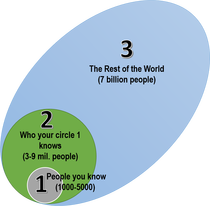 The Three Circles of Your Network Shared experiences can build trust, and trust is a foundational element of commerce. The Three Circles framework helps you categorize your potential customer base. It then helps you position your messaging. Our research has shown that a prospect's behavior changes based upon past shared experiences. It appears that there is a high incentive to draw those far from you into your circle of customers who trust your offering. Give it a look and then think through how you might craft your next marketing message. 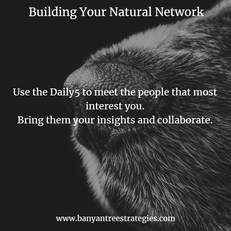 Building A Network One Coffee Cup at a Time If you are working in a metropolitan area being in close proximity to other professionals provides you with the opportunity to do what interesting people are already doing and create a first shared experience. We named it the Daily 5 - Breakfast, Coffee, Lunch, Coffee, & Drinks -because we noticed really busy people still doing all five quite often. Why not just ask them if you can share that time with them and share insights? All you need is a plan, the guts to ask them, and a premise to help them or provide insights. The key is to get one or two slots a week where you get out of your work rut and broaden your horizons with interesting and influential people. Our how-to white paper on the topic is here and is also on our courses page at www.banyantreestrategies.com. Cheers to the next five years! Drew and Sara Grading Your Goals Happy New Year, and welcome to one of the most productive 45-day segments of the year. The collective surge of our world’s re-prioritization of all things work-related can be felt by all our senses. The team at Banyan has been busy preparing a year of relevant insights as you lead your teams, and we are happy to announce that a sister site and blog at www.drewsanders.com is now live to assist individuals at key inflection points in their lives. Both sites will work off the same platform, offering advice in small consumable amounts, and the new site is just starting to evolve. The menu of options will also allow users to pick a course and receive items in a PDF or a series of emails. The emails will direct you to answer questions to develop your own learning. Your answers will be organized and emailed to you automatically. Our aim is to equip you with relevant knowledge that you can use in key areas of your life. We will pick the topics based upon the work we are doing for clients and friends. If you want us to research an area for a future course, please let us know.  Fresh Look at Goals Five years ago we started Banyan with an eye for helping companies improve their performance, and we have sat in on numerous goal-setting sessions. Goals can make people be sick to their stomachs, and goals can be used as a weapon, but isn’t that kind of missing the whole point? Today, we offer you a new way to look at goals, and hope you might consider giving it a try in one area of your life. It starts with a mindset that focuses on goal attainment, and uses the concept of school grades to dole out the rewards. If you reach 90% of the goal you get an A, 80% you get a B and so forth. C’s get degrees in school and historically is considered the average. Yes, we can hear you thinking, that may be good for school, but this is the real world. If you don’t hit your goal, you might get fired! Here is why you might want to take a closer look at this mindset if you are a leader. When you give your team a goal, you have 'goaled' them. This rhymes with scold. We think you should keep that image in mind. Teams that are assigned goals do not stretch, or reach, and some of them don’t even think. They just deliver the goal and oftentimes will do so with a nice passive aggressive, up yours buried somewhere in the result. You the leader lose out on a major chance for upside when you make the goal the minimum acceptable standard and think that your team will still work to exceed the goal because they want to go the extra mile. The financial rewards that come with goals are highly motivating to some. However, the intrinsic motivators of choice, autonomy, competency, and progress can have a huge impact for your joint benefit. We are noticing that the following recipe can really pay off with your teams. Step 1: Share the goal attainment mindset with your team, and walk them through how the compensation will work, and how you are viewing job security tied to goal attainment. It is up to you if you want to let people go who are 79% to goal or 69% to goal. It is fair to assume that everyone knows a minimum acceptable standard is necessary. However what you are looking to accomplish is getting most of the fear out of the room and allowing for some creativity to show up. Fear based goal setting can get you 60% of a person’s focus. The other 40% will be based on self-preservation actions like looking for work elsewhere and kissing up internally just in case. When you dial down the fear, laziness doesn’t automatically show up. Initiative and collaboration have time to breed and the results can be fantastic. Step 2: Have an open ended conversation about what is actually possible with your team. This may take time as you switch to the goal attainment mindset, but a fair and brisk discussion about what could happen might be revealing. Leaders often don’t really know what others are thinking because it is not in the team’s best interest to share, as it might turn into an all or nothing goal. The lack of trust that is built by perform or perish goals is significant, and once you are openly hearing what might be possible from your team then you are on the right track. Step 3: Set up your goal tracking cadence and then listen for the stories. Meet on a regular basis and don’t skip these meetings, you have to be in the hospital to miss this meeting. It is that important that you, as the leader, are on this call. Listen for the stories, as they are a sign of something going differently than people had hoped. Don’t jump on them in public, but privately meet with the story teller and work through to what is changing. Identify if it is an internal issue like time management, or an external issue like a change of leadership at a large prospect. Address the issue right away and help keep this person in the process of the best actions that lead to success. Once your team is actually striving on their own towards a goal they want to achieve, they will start to fail. Don’t miss the chance to work through these failures together! Step 4: Treat success and failure as tools for everyone’s understanding and development. One of the side benefits of a goal attainment culture is it increases the amount of sharing. Everyone should be able to perform well enough to stick around, and now you are focused on getting everyone into the A category. When someone succeeds, share it. When someone is getting stuck, share it. As the leader set the example of not judging failure, but observing it. The difference is that judgement is looking for blame, and observation is seeking clarity. Creating a workplace with clarity of purpose is a leader’s job. On the pathway towards accomplishment the world will present obstacles. You want to know about the obstacles in your team’s path immediately. Cultures of fear have worked for centuries. We are not saying they don’t work. We are offering an alternative mindset which can require more consensual interdependence between the leader and the team. We have seen it make a real impact and will continue to share our findings for leaders to consider. Would You Wish Your Children Bad Luck? As the saying goes, one of the most competitive sports in America is parenting. This has been taken to a new level in recent decades with elite schools not growing their admittance pools, then why is it that the new standard is for college graduates to move back home? Have we extended adolescence in a perpetual state of not wanting to disappoint our children? Should we disappoint our kids? I know, great idea Drew and Sara, you try it first and let us know how it works out. Well, thankfully Chief Justice Roberts has come out and done it for us in a recent speech to a group of 9th graders, and it is summarized by well-known author Bob Greene. If you are a practicing parent of any age and you have thoughts on how to weave in some disappointment into the threads of today’s K-12 education please share and we will make sure to incorporate it in our communications. Correlating this concept with our prior thoughts on goals, it appears that striving brings about failure, which brings about reflection, which leads to learning, which leads to dreaming, which leads to hope, which leads to action, which leads to striving. What a great loop! Setting Personal Goals With Words You have a really good chance of being in control of your attitude. If you don’t like static goals like make this much money, buy that car, or climb that mountain, consider setting some attitude goals. You can achieve them at some point every day, and that accomplishment may just propel you to achieve something else. We suggest you change up the attitude goals for the different relationships in your life. Here is a template for you to use and print out and below I share mine for 2018: 2018 Attitude and Behavior Goals: Self Breathe, Observe, Smile Marriage Listen, Encourage, Support Children Hug, Cheer, Model Extended Family Love, Care, Share Work Create, Engage, Pursue Remarkability Recreation Move Daily, Sing, Swim HAPPY NEW YEAR! Drew and Sara Thankful For You Welcome to the last days of 2017 and our final communication of the year. We have a few observations from the previous 45 days of October and early November hustle, and hope they will help you in some way prepare for the holidays and their inevitable bustle. In this edition we have a top ten list question, an eight touches a year idea, and a 397 year old connection. Who Were the Top 10 Most Interesting People You Met This Year? This idea was formed when we shared with someone in an email that they were one of the 10 most interesting people that we had met in 2017. It was a true statement, but we hadn’t really thought of the other nine yet. However, upon reflection, we knew any list we created would have that person in the top 10, so we thought they would like the encouragement. This got us thinking that at the time of year when people gather with family and old friends, that you might have some fun thinking about a list of the new people that you really enjoyed meeting. What made them interesting to you? Were they as interesting to others? Was it that they had power and influence or talents you appreciated? Consider making a list and then reflecting on not only who they are, but why they were interesting to you. Compare it with your close friends and then have a fun discussion on what the list says about both the admired and the admirer. Looking ahead to the holidays, this idea might make some of your old hat family dinners a little livelier than in the past. Is It Time To Kill All the Golfers..? We thought we would inject a little humor into a tough subject that is often associated with the end of the year. Reaching the annual sales target. The idea came out a series of discussions with business owners and suggests that this can be a good time of year to remove a certain type of lead that is clogging up the funnel. These aren’t the clients or the deals that have momentum. There are plenty of deals getting done prior to the end of the year, and Dec 31st is a wonderful impending event to create tension and focus for both buyer and seller. These are the potential business relationships that just make both sides feel awkward. They look and sound like this: CLICK HERE FOR FULL TEXT In Caddy Shack terms....you are killing all the gophers!! 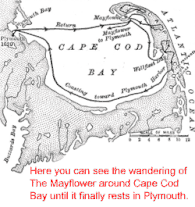 The Five Kernels of Wisdom 397 Years Later November 15, 1620 witnessed The Mayflower at anchor near the shore in Cape Cod Bay. Four days prior they had arrived and were now assessing the best place to build their colony. The first few years saw them face immense hardship from the seasonal conditions and tremendous friendship from the Native American’s. There also was an ill-timed and named visit by the ship The Fortune in the early years which didn’t bring much needed supplies, just more colonists and professional sailors looking for clothes and sustenance. As a way to remember the famine and lean times the lesson of the 5 kernels of corn and their significance was created in the early 1800’s and has since been shared throughout thanksgiving tables across our country and a copy for your ready reference is here. Today there are tens of millions of descendants who are alive because of the fortitude and resolve of those early settlers. Over the course of the next three years as we reach the 400th anniversary of the Pilgrims of Plymouth Rock we will share with you in the final edition of each year the stories that are told as America reaches this new milestone. Kernels can be like pearls, associated with wisdom and this is our hope for each of us as we age. The ability to learn from the past and share it with others. When you think about what you want passed on to your family members this Thanksgiving, what is it? What are your hopes and dreams for them? 397 years later is it that much different, the wish of a mother or father for their children? We thought it would be only fitting after writing about the Mayflower to thank you for your ship, more specifically your readership, mentorship, and friendship in 2017. See you in the New Year! Drew & Sara Visions and Attitudes Welcome to October and the fastest 45 days of the year. The first six weeks of the 4th quarter are a doer’s dream, no matter the setting the players are playing. If it is going to get done in 2017 action is required. A challenge that arises with all this activity is what to do first, and how to work with others when accomplishing larger tasks. These choices fall right in line with the conversations we have been having with leaders for the last five years and sharing with you in Branches & Roots. A lot of it comes down to this question: who is going to do what by when, and whom are they going to tell about it? Our most recent conversations have been centered on visions, budgets, attitudes, and energy. We hope these summaries are helpful for you as you lead yourself and others through this short six week season. Does Your 2018 Start With a Budget or a Vision? We have found the answer to this question changes depending on the location and altitude of the person you are asking. What about in your own life? Do you start with a set of numbers, or with a dream? Your financial position is a vital component of your decision making process, money has rules and realities that are as consistent as the law of gravity. What you can afford to do and how to allocate your resources is a vital constraint you should have a handle on for 2018. In the context of business, we have had a similar conversation several times in September. What does the budget look like for 2018? Who is getting more, who is getting less? It keeps your eyes down and it kills creativity. In this scenario you grab as big a budget as you can, and then justify how you are using it during the year to help the unit, and your compensation for overseeing the projects. We have come to call the people adept at this tactic BUDGET HOUNDS because they can smell the scent of a budget a mile away and think of little else once on the trail. Our observation is that being a budget hound maybe good in a crisis when you are just trying to get to the next year, but if you want to get somewhere different and better, you need to learn how to dream. We all need to practice dreaming, and then writing those visions down and turning them into action. Jeff Foley is a retired Brigadier General and a friend. In 2015 he gave a Ted-X talk in Augusta, Georgia where he walked the audience through how to script out a vision for the next five years.
Your budget will help you get there as a constraint for financial discipline, but without a vision and a written out target your chances of meeting those goals are slim. Enjoy Jeff’s video where he talks about Character, Attitude, Vision, Excellence, and Relationships and how they can all fit nicely on a yellow pad of paper. Attitudes and Energy
These are the mantras I heard growing up and have continued to share into adulthood. Few people would contest the fact that attitudes matter; it’s just such a pain to changing them in others. Most of the time we just move on. Recently, we encountered a situation where a leader couldn’t move on. They had a team that was mostly bulletproof from a job standpoint, and it was the manager’s job to improve the productivity for the company. Blowing off the attitude was no longer an option. What to do? Through research and interviews we started to tease out how attitude and energy (or what some might call productivity) are highly correlated. From a science perspective this is not a ground breaking discovery, most parents have come to the same conclusion. The learning came from just how quickly we could turn attitudes around, and tap into the hidden energy reserves with some well-timed listening and consistent leadership behavior. The simple science: Miserable people do not outperform optimistic people. Optimistic people are distracted less and stay on task. They are optimistic because they know the answer to the question: why am I here, and why does this task matter to me and others? The learning: To get a group of miserable workers to become optimistic when you don’t have the ability to pay them more, or even make their work day that much different comes down to understanding how to use gratitude as a trigger for changing attitudes. You then identify the influencers and listen. Mark when and where they are either leading the team higher or lower from an attitude standpoint. Do some careful study work with the influencers, away from the group, and find the key intrinsic motivators (see image below) that matter to them and the group. You should be able to meet some of the intrinsic needs of choice, autonomy, progress and competency within the construct of the required tasks. That combined with gratitude as an agreed upon foundational value of the group, has proven to turn a group of miserable adults with a boss into an optimistic team with a humble leader. New Branches Banyan is working on its own 2018 to 2022 vision and we will be testing out a few new micro-brands. “The Team Leader Club” and “Leadership Hub” are both concepts we will be sharing as we create content and learning offerings for people in the five theaters of self, family, work, community, and your network. Our current thinking is to offer our expanded network of 3100 followers a series of member benefits for being under the canopy of Banyan Tree Strategies. You are a member, you belong. Several questions we have been noodling on are:
Prioritizing, Publishing, Mentoring Most of the summer vacations have now concluded and the rapid pace of fall meetings and events are right around the corner. We heard many tales of great summer trips and experiences and we hope you were able to use the longer days to recreate yourself and reflect on what matters most to you and your closest relationships. We enjoy sharing our learning every 45 days with you in the hopes of stimulating interesting discussion between us, and potentially between you and others. In this edition of Branches and Roots: - We analyze how constraints develop your skills - How LinkedIn can help you amplify your career even when you have a great job - What being a mentor can do for the second half of your career. Got A Template For That? Building off the great reaction we received from our post on productive solitude we started to notice that in many of our work conversations we were asking leaders how they were organizing their thinking and in what format. Were they using a computer, a phone, a note pad, or a bound notebook? When did they collect themselves and organize? Who did they share it with, and how did they share it? The answers were all over the board, and many didn’t really have a system in place. They offered up that they are bouncing around trying whatever the newest form of technology has to offer. We also noticed that many leaders thought that the idea of sharing what they are doing to be a big enabler for productivity, however, that wasn’t really playing out as they thought. It was leading to more emails and more confirmations on non-mission critical tasks. Does this sound familiar? Enter in the concept of a template as a way to create boxes waiting to be filled in with answers that challenge you to prioritize your thinking. An individual benefits by working with a task allocation template like the one below. The act of not just writing down your tasks, but prioritizing them, and then estimating the time it will take to complete the task has a calming effect. It gets your to-do’s out of your brain. Once you have written down your tasks you can then share it with others. If you are the manager of others, consider using this template as a tool to help them develop their own way of thinking on how they are allocating their time. There are plenty of smart people who are horrible at allocating their time, and it is hard to coach them on this without appearing overbearing. Asking them to complete the template will give you a window into what they think is most important and could foster some healthy dialogue around their choices. Constraints have long been used by athletic coaches to help players practice longer, and to develop a certain piece of the puzzle. When we are helping someone with their putting in golf we often have them putt with just their right or left hand to increase their awareness of a specific part of the stroke. Similarly, having a direct report complete the above template could build awareness around the importance of allocating their time tied into their team's needs relative to their own. The Long Tail Game and How LinkedIn is Helping You Build Your Brand It was front page news in 1982 when IBM announced it was laying off employees, the security of lifetime employment with Big Blue was in doubt. The undertone to others was this meant that almost no private sector employee was safe. From moments like that 35 years ago to today, the idea of a personal brand and its cultivation have been forming. You, the individual, have the ability to create what the brand marketers will define as a 'promise wrapped up in an experience' and LinkedIn has been building a platform for your brand since its founding in 2002. In the last five years LinkedIn has not only been a great place to store all of your contacts, it is a great place to share your thoughts and perspectives. In a business world where almost all employment contracts are “at-will” (which means you are working week to week at the whim of your boss), it is increasingly important to have a place to share what you have to offer an industry or marketplace. There are several key actions to consider when it comes to publishing on LinkedIn. The first is to share what others have posted and add your comments. This is easy lifting and benefits the person who created the original content. The second is to set up a writing schedule and some topics you like to cover and start sharing your own thoughts. This content will live online for a long time, and can be referenced by you on other websites. The power of written content for your career has a very long tail. The most recent development from LinkedIn is the ability to share a video. While this may seem like the last thing any of us want to do, it will have an impact on how we learn, and what we expect when meeting new professionals. If you were looking to hire someone and they had a short clip about themselves, it could be of great use to see how they communicate and handle themselves in front of a camera. Two generations removed from 1982 the relationship between corporations and individuals has evolved into a measured marriage. Individuals now have the option of creating and maintaining a professional store front on LinkedIn, a place to store not only contacts but their work product. You own your career and we see LinkedIn as a valuable partner. 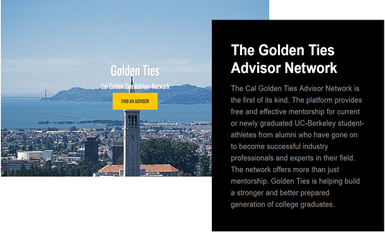 Allowing Wisdom To Rise Having a trusted friendship with a person years older or younger than you is a true gift. We often refer to these non-familial connections as mentors or mentees. The roots of the word go back to ancient Greece when Mentor who was a friend of Odysseus was entrusted with the education of Odysseus' son Telemachus. Relationships that are strong have certain elements that help them build. Affinity, time, shared experiences all are ingredients. One of the outcomes from a strong cross generational relationship is that it can allow the subtle gift of wisdom to present itself. When wisdom arrives it means the mentor has built up enough trust with the younger party to share their best insights and perspective. Often times this can be life changing for the mentee. Yet for all its benefits, great mentors are in short supply. Why is this? It may have something to do with the all-important shared experiences. The generations don’t always do things together, and thus it is hard to form the bonds. Technology hasn’t helped. Then there is the hubris of youth always thinking there has to be a better way than it was done in the old days. We share this as a preamble to what we think is a great new mentoring system that has been built by the team at Instaviser. It is an internal mentoring engine that institutions can use to allow the younger generation to connect with the alumni. We were introduced to it through our involvement with Cal Athletics. Instaviser branded Cal’s system with the name Golden Ties and Drew was asked to be a mentor. On several occasions a Cal student-athlete was able to find Drew’s profile on the password protected site and book a 30 mentoring session. In both situations the common connection of having gone to Cal was enough to allow an easy conversation to ensue, and the beginnings of a relationship were born. The student-athlete had questions about work and job opportunities, and I was able to offer some thoughts and people for them to meet. So many of our work and nonprofit institutions have a treasure trove of wisdom locked up in the minds of its elder participants. We will all benefit as it is transferred to younger generations. Hopefully solutions like the one Instaviser has built will gain traction inside the institutions you care about, and we will be able to pass down the principles and values to tomorrow’s leaders. If you have an interest in being a mentor on any topic, please email us here and we will do our best to get you connected with the right team. The Halfway MarkHappy 4th of July weekend and welcome to the half way post for 2017. Summer affords us the chance to reflect and recreate. While enjoying a post dinner stroll, consider asking this: what did we learn in the first six months, and what does it mean? Our walks, conversations, and readings in the last 45 days have led to some learning in the areas of: leading yourself, your family, and your team at work. The Power of Productive Solitude What framework or structure have you set up for thinking? Where do you think best? Many people don’t know off hand, but after a minute or two might share that they think best when alone. We recently stumbled across a book on leading yourself, and have been enthralled from the very beginning. “Lead Yourself First” by Ray Kethledge and Mike Erwin is a qualitative study of how past leaders have used productive solitude to make key decisions. We are now 10 years into the era of having a super computer that is in your pocket. 1.2 billion Apple iPhones have been purchased, and our new behaviors around them are only just becoming understood. It could be stated that one of the outcomes we all feel is some sort of attachment to the devices. Just as the washing machine replaced the scrub board and freed up hours of our week, so has the super computer in our pocket made our lives easier. Amidst the ease might be another driver, in terms of connectivity to others as the home-run app; whether it is via text, email, or a social platform like Facebook. Belonging feels great. Counter to our need to belong is our need to be alone. This natural tension between autonomy and belonging has been dealing with a new actor for the past 10 years, and it appears that alone time is shrinking. We now have to choose to be alone, and “Lead Yourself First” comes along at an interesting time, making the case that in order to lead and make a contribution to others, you need to be able to think for yourself first. Which brings us back to our question of: what framework or structure do you have to allow you to collect your thoughts? If you have a free minute and enjoy this topic, please share with us here how you build your thoughts to make key decisions.  HAGS The school yearbooks came home the other day with both kids smiling from ear to ear and ready to show us all the wonders within. Thirty years have passed since that bound accumulation of all our relationships, both good and bad, were in our backpacks, and it was pleasing to see that it still held its attraction with today’s youth. Inside the cover amidst the longer messages from the good friends was an abbreviation that has stood the test of time. H.A.G.S. As adults helping guide the family through life, the notion of having a great summer has a different connotation. It comes down to making sure you have a summer at all, that you can stand there on Labor Day and say, yes we actually had a summer and it was great! We took the time to get away and let rashes and skinned knees appear and even allow some wondering and boredom to present themselves. Making a contribution to your family's great summer is a curious challenge no matter what your role. We doubt it will require great amounts of funds or an amazing destination, it may just be instituting a regular game of cards or figuring out which board game everyone enjoys playing. Whatever you choose, having a great summer leads to a fantastic fall, so try and do something different and distinctively unique this season. If you were headed back to school, after this summer would you be able to write an epic edition of that timeless teacher faithful, “what did you do this summer?” 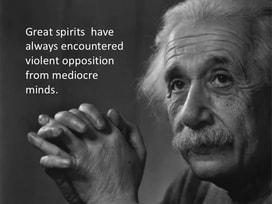 The Consequences of Mediocrity One of the major headwinds to a great summer is if you are only 50% of the way to your annual goal by now, you are actually behind the number, because you will lose ground in Q3, and may not have the time to catch up in Q4. Being below goal is not a happy place, and could even be considered mediocre. If you are the leader it is easy to blame your people, but in a recent article by Joseph Grenny he articulates why it might be the leader's fault, and he shares a couple of ways to bring the big middle of your team up a few notches. Grenny is the co-author of one of our favorite books “Crucial Conversations, tools for talking when the stakes are high”. In this article he wrote for the Harvard Business Review he shares several ways to help the team visualize what their indifference could cause. We think this hits the spot when it comes to larger group activities. The big middle is too easily swayed by the 'who cares' crowd, and the costs to change the bias by those in the middle is too great socially. As a consequence, a status quo of “slow it down” vs. “pick it up” is established. The ability to stimulate a “let’s pick up the pace” mindset rests with the leader, and Grenny shows us how to tease out the inner hard worker in your workforce. No one wants to be average, and yet by rule there always is an average. However one of the synonyms for mediocre is the word forgettable, and seldom seen is the human who when presented with the option of being remembered or being forgotten won’t choose the former. Once convinced and bought in on being remembered, the leader then shows and teaches the tangible steps and behaviors that lead to success. Pretty soon your group may start acting like a team, and as the leader you may start to feel that surge that comes when humans care together at scale. Like all people puzzles it may be hard, but it’s worth it. H.A.G.S Contented Cows? Be True to Your..Company? Do Your Job! Team Flow. Welcome to the middle of May, a time of great energy and action, with a hint of distraction in the air. Memorial Day looms and quickly beyond lies…summer. Sharing what we find of interest every 45 days has been a challenge in only that we have to narrow our selections. Options abound. Longtime readers will know that the study of performance as both an individual and a team is what we metaphorically call our “Soup,” with our interpretations of it offered to others being our “Art”. In this edition we turn our attention to employee engagement. Tension exists around the topic of how to get the most yield from an employee. In this issue we share a series of articles that discusses what is working at places ranging from a dairy farm in Indiana, to the halls of Facebook, to the locker room of the New England Patriots. Contented Cows? It turns out that the software engineers of the Silicon Valley have some competition when it comes to perks at work. The dairy cows of Kelsay Farms in Indiana may not have Foosball tables and free lunch every day, but they do have waterbeds, custom back scratchers, and cool air blowing on them. Why all the fuss? Because a happy cow is a productive cow, especially with some of the milk going for $14 a gallon direct to consumers. Now, a cow can’t talk and who knows at what point there is a diminishing return, but the amount of milk per day produced is pretty easy to track. As of today it appears the “encouragement” camp is working on our bovine. 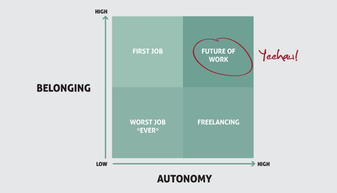 Be True to Your....Company? Most will know the Beach Boys song from 1963 as “Be True to Your School”, yet current research being done by Adam Grant at Facebook has started to show that pride in your company can have a large impact on the amount of work the average employee will produce in a day. It can graphically be represented on an axis of belonging and autonomy. People love to have choice, and they also love to belong. When they feel that their company's purpose aligns with their own values they take more initiative. The new haunting question for leaders may become: are you proud of our team? What a powerful yet challenging question for many work environments. I can just see several of my earlier bosses falling out of their chairs in laughter. Does this mean we need plenty of circle time and not challenge each other? Is the chain of command completely broken and the inmates are running the asylum? Not necessarily, as discussed in this article from the May edition of Fast Company.  Do Your Job! Now here are some words that maybe a few more of us are used to hearing. Do your job. This is the sign posted in the New England Patriots locker room. With recent history as example, it appears they players are listening. The usual reluctant public communicator coach Bill Belichick agreed to sit down with a CNBC reporter recently and talk leadership, as well as the concept of getting the highest performance out of each player. The principles are sound, the behavior needed is clearly defined, and with a game that hasn’t changed its boundary lines or ball size recently the basic strategy can be deliberate. In this scenario the life time production of the player relative to the contented cows may seem similar, as both have water treatment facilities, yet with the average tenure of an NFL starter coming in under three years, we are guessing the rules and leadership strategies might reflect the duration of a performer. Regardless of tenure, the players on the roster are under Belichick’s care, and even this apparent hard liner speaks to caring about his players. Team Flow We close by bringing it all together with a man with the hardest last name in the world to spell. Mihaly Csikszentmihalyi was a young boy in Europe at the start of WWll and has spent a lifetime studying the highest of performance states, FLOW. His research has been the bedrock for most of today’s top sociologists. We all know when we have it, we all know when it is gone, and as leaders the challenge of obtaining it as our numbers increases grows. It is the Leaders Challenge and as always any insights into how you have been accomplishing Team Flow are most welcome. His Ted Talk is linked below. Your Humble Momentum (Mo) Leaders drive the key initiatives in their own lives as well as those entrusted to their care. This past Friday marked the end of the first quarter of 2017, and if you put your ear to the ground you can hear the wheels of commerce spinning at high speeds. Ending Q1 with some momentum is a big deal. How was your Q1? Did you nail it? We hope you did, and are going to focus on how to keep your momentum going in this edition of Branches & Roots. Momentum's Recipe Way back in 2013 we released a golf story about momentum, and have been students of the discipline ever since. Our recipe includes three targets with three correlating hazards. • At the start, present yourself humbly before your task, and be mindful that expectation is not your friend. • Treat ups and downs with a similar hand, and don’t let your mind drift ahead while in the middle of your race. • As the crescendo builds, pursue your best performance for the performance’s sake, and allow the darts of the wicked and your own doubts fall upon a tin ear. Thinking about 2017, we are entering the middle of longer days and rotating schedules, while people balance the tasks of progress and accomplishment with the escapes that allow for silence and reflection. A hard winter is capital's friend, while summer provides a pleasant distraction. The past six months we have posted a daily image in five leadership theaters to build out a micro-brand by the name of The Team Leader Club. The genesis of the club came from a client who wanted to offer her team a daily boost of leadership encouragement. Everyone is a member of the TLC, and it reinforces that we are all leaders in different settings, and that each situation often requires a different style of leadership. To keep your momentum going for 2017 we offer three images that hopefully will help you as you lead yourself, your family, and your work team. If things are not going the way you want them, or you are looking to change things up a bit, consider a ten-day micro sprint where you re-prioritize things to make one task or issue number one for you and the team. This process allows other issues to rise to the surface, and it can potentially lead to flushing out a buried conflict that is distracting your team. Charles Duigg writes about this in his best-selling book The Power of Habit. Read a few pages in the preview to start changing up habits. If you have a method or recipe for team momentum we would love to hear from you. Thanks and have a great next 45 days. Keep the Mo going! Banyan Book Store
We have recommended a lot of books over the years in our newsletter, and are frequently asked about ones to read on a variety of subjects. If you would like to browse the selection of books reviewed or discussed in Branches & Roots, check out our virtual library. The Message Matters The first 45 days of 2017 have been active. Who is going to do what and by when are the main topics. Our work had us either facilitating for a team, engaging in dialog with an individual, or observing a company in action. In all three of these settings we became aware of a key differentiator in performance tied to a specific moment, and hope by sharing it with you that it might stimulate a discussion with your team. The moment of influence is when your product offering or service comes in contact with the customer, and things are not going as scripted. What gets said and how both sides are left feeling appears to have a large impact on customer satisfaction and employee engagement. We also noticed that when a leader sits down with their team and helps them jointly craft what to say at these moments, and ties them back into the teams internal values, you have the potential to tap a powder keg of productivity. These have been 'aha' moments for us, and we are excited to share more detail on this below.  Flying the Friendly Skies Vs. the Feeling of Love A recent business trip had us back on United Airlines instead of Southwest, and we noticed a great example of how the flight attendants on Southwest have just the right language to handle a frequent conflict point, and the team at United does not. On the evening United flight home there were 10 bags that had to be checked at the gateway. This changes the duration of the flight by an average of 30 minutes for the person who now has to go to baggage claim. United had increased the flight time of the passengers on that flight by 300 minutes. As I put my sport coat into the bins that must have been packed I was dismayed at how much room there was. In one striking example a ladies white handbag was all by itself. Compare this to the flight on Southwest the next week -which was just as full - and there were no bags checked. I witnessed a similar hand bag being pulled out by the flight attendant, and then with the tone of grace and the firmness that comes with her uniform she asked the owner to place it in the seat in front of her so other travelers could get their luggage up in the bins. Our perspective is that the training Southwest puts their team through to handle the common conflict points is not just good for the customer, it really empowers the employee as well. The crew at United were very friendly, they were hustling, and they have a long list of things to get accomplished. Yet it was clear dealing with the issue of how people shirk when in groups, and not having bags checked was not something they had prioritized or practiced. When you have a team member in a position to work with a customer of any kind consider carefully the language you have empowered them to use. If it isn’t practiced you are leaving up to chance the satisfaction of both the customer and your employee.  The Three Leader Laments That Are Killing Your Culture It may not be a welcome point of view, but a haunting reality started to appear to us about what happens when a leader laments, or complains. It guts the commitment of almost everyone on your team. We identified three of these culture killers and share them in the hopes that you may check yourself in your efforts to improve. The first lament comes in the form of getting off focus. This occurs when you take different courses of action that are in your head, and start to leak them to your task-oriented team. Your team wants to know what you need and what is the plan? If you are winging it or juggling multiple strategies, and thinking it doesn’t matter because they don’t tell you about it, think again. They are not going to tell you, almost instinctively they will cut their commitment by 30% immediately. The second lament comes in a moment of frustration when small items are brought back to you by the team. The questions are low level, off topic, and drive you nuts. Your response appears to be a clarifying statement, but it also stops your team in their tracks. “I Don’t Care” about this or that the leader says and admonishes the person for bringing them something small or trivial. But wait, if your direct report cares about it, and you the leader say you don’t care, then why should they care? These are just the wrong words. Leaders can’t say them. They are a sign that the team is struggling solving a problem and they don’t have the language or the latitude to resolve an issue. This is a teaching point for the leader and the team at the right time. We all have said, “I don’t care” at one time or another and we meant no harm, but harm is done right down to the very core of your teams engagement. The leader has to care. The third lament of a leader that guts the engagement levels of your team is allowing people to share the stories of how people have lost their jobs. Myth and story are life staples for humans and it is only natural for bad news to be shared inside human systems. Yet some companies don’t realize how much damage a culture of fear can have to employee engagement. Leaders can’t dictate what is and isn’t said on every topic, but they can model the right behavior by not joining in the stories and by sharing with the story tellers what the consequences are on both sides of the telling the “people get fired around here” stories. If you are looking for your front line to think and move with purpose you want them to feel empowered to make decisions and communicate. They need to be able to make mistakes of commission while moving towards the goal. When a leader allows the fear to reign, they cannot then expect people to think for themselves. It is just a bad bet for the employee and leads to the worst kind of person, the one who quits but keeps showing up to work. 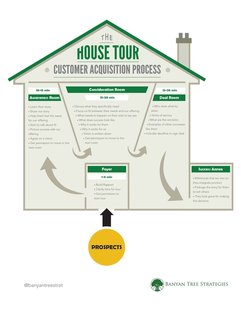 What A Trip to Mt. Vernon Can Teach Anyone About the Pace of Sales Dialog We recently observed a sales meeting for a software company and were asked to listen to a new inside sales rep role play to learn what to say to a prospect. The tone and confidence were there, but we didn’t get the sense that the conversation was going anywhere. When asked for feedback I wanted to come up with an image that wasn’t tied to sports, so asked the new employee if they had ever been on a house tour like Mt. Vernon where George Washington lived. She replied in the affirmative and so I asked, do you think the tour guide is in sales? From this question a nice dialog ensued where I was able to get my point across that different types of dialog have different pace to them almost like a music score. In the case of Mt. Vernon, the tour guide needs to keep us moving on the treadmill so the group behind us can view the room, and they want us to connect with the house so we spend money at the book store. The image of the house tour resonated and so we broke out the stages of a sale into different rooms of the house and started sharing it with other companies. We have been calling it “House Tour Theory” and are enjoying how it applies to a range of institutions. Non-profits, professional services, and software companies have all been able to tweak the conversations in the different rooms, yet they agree that the conveyor belt should always be moving forward. Feel free to use the image below for your customer acquisition and success processes. Please share with us how it works or needs tweaking for you. The three moments of maximum influence: a customer service conflict point, a leader lamenting, and the salesperson keeping the deal on the conveyor belt. In all three, The Message Matters!
Have a great next 45 days and see you on or around April fools day! |
Archives
November 2023
Categories
All
Complete Annual Newsletter Volumes
|
